Management Control System
VerifiedAdded on 2023/04/23
|24
|5474
|491
AI Summary
The report evaluates and assesses the management control systems in Oporto –fast food company especially the central station branch. The report will also make suggestions for enhancements and improvements for better outcomes. The report critically evaluates the observed management control system and provides suitable practical suggestions on the improvement of the current systems.
Contribute Materials
Your contribution can guide someone’s learning journey. Share your
documents today.
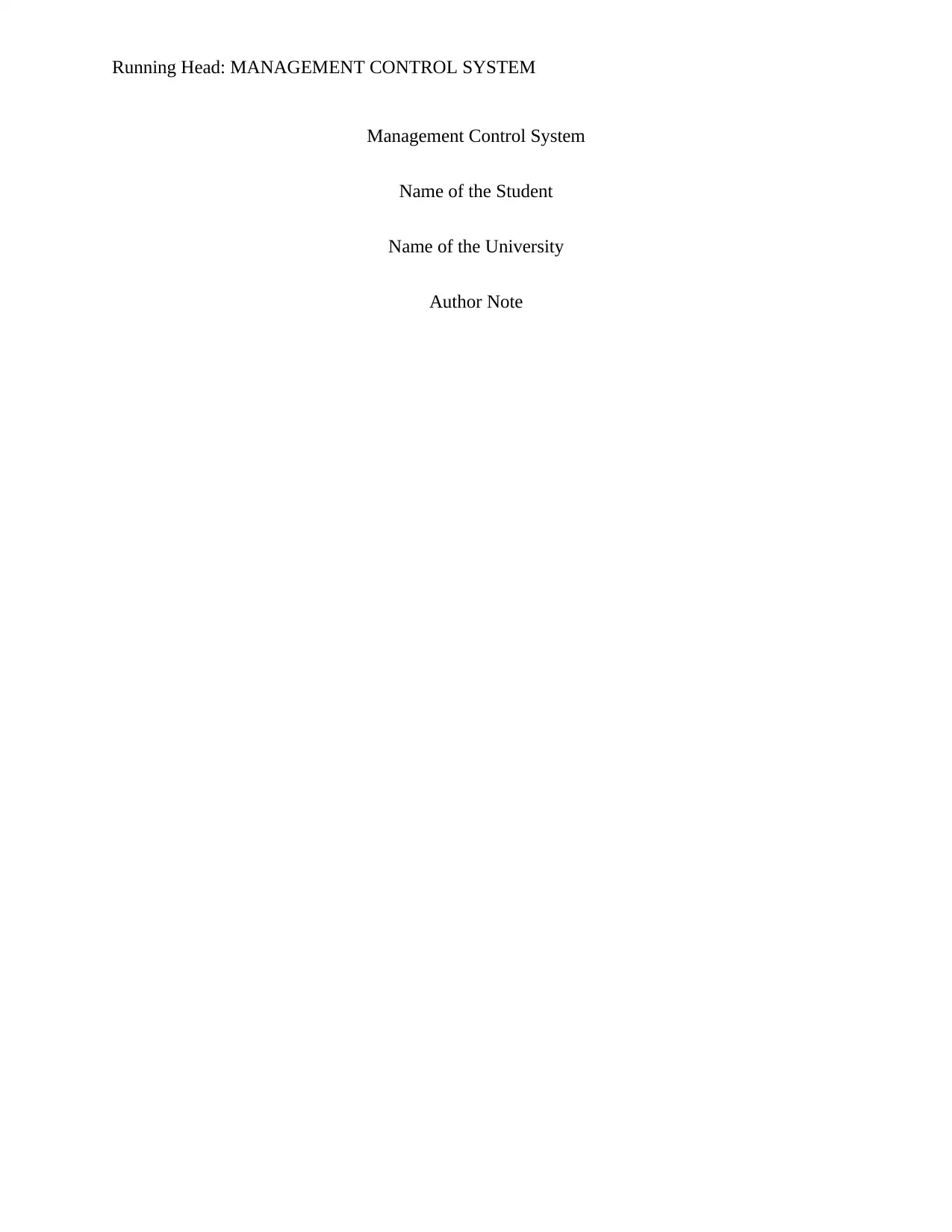
Running Head: MANAGEMENT CONTROL SYSTEM
Management Control System
Name of the Student
Name of the University
Author Note
Management Control System
Name of the Student
Name of the University
Author Note
Secure Best Marks with AI Grader
Need help grading? Try our AI Grader for instant feedback on your assignments.
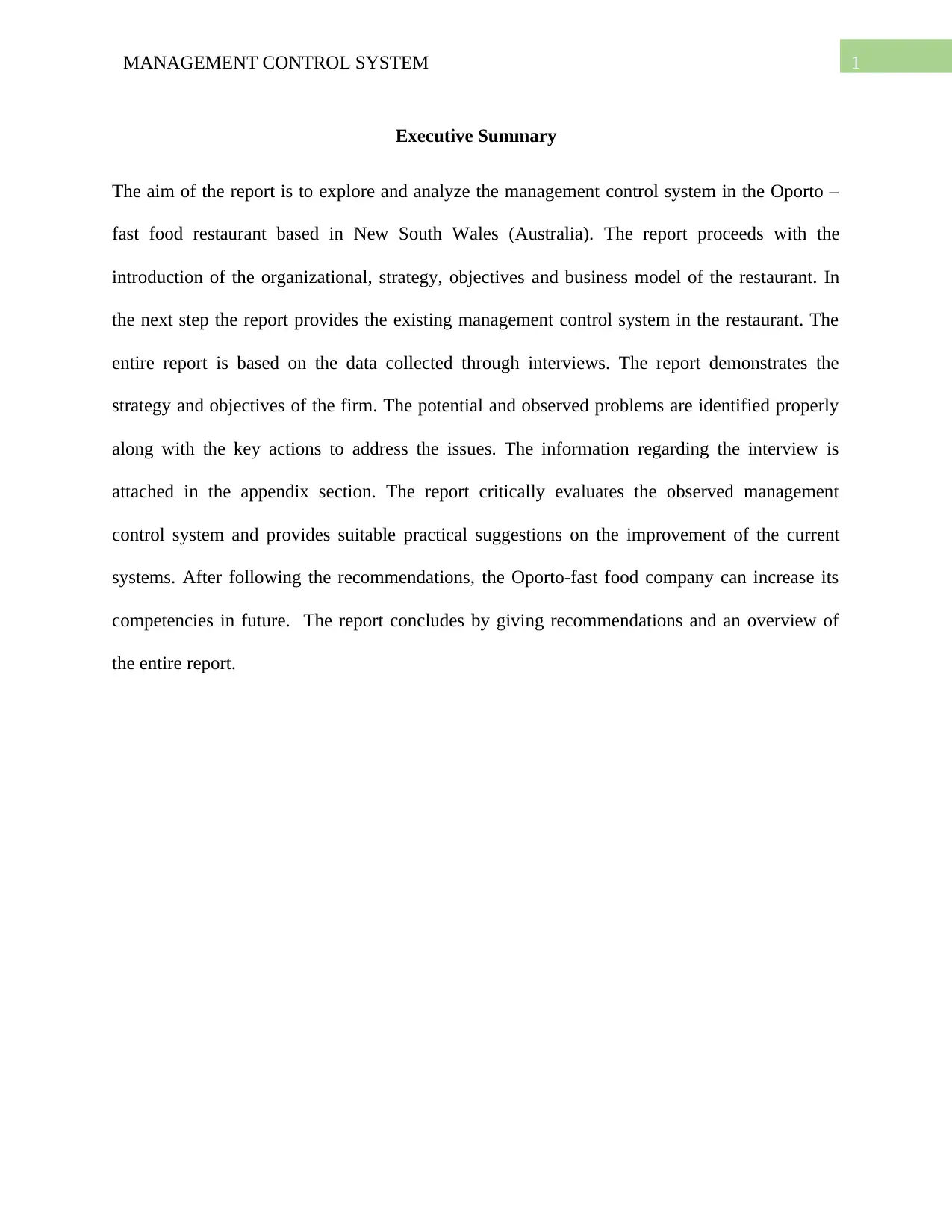
1MANAGEMENT CONTROL SYSTEM
Executive Summary
The aim of the report is to explore and analyze the management control system in the Oporto –
fast food restaurant based in New South Wales (Australia). The report proceeds with the
introduction of the organizational, strategy, objectives and business model of the restaurant. In
the next step the report provides the existing management control system in the restaurant. The
entire report is based on the data collected through interviews. The report demonstrates the
strategy and objectives of the firm. The potential and observed problems are identified properly
along with the key actions to address the issues. The information regarding the interview is
attached in the appendix section. The report critically evaluates the observed management
control system and provides suitable practical suggestions on the improvement of the current
systems. After following the recommendations, the Oporto-fast food company can increase its
competencies in future. The report concludes by giving recommendations and an overview of
the entire report.
Executive Summary
The aim of the report is to explore and analyze the management control system in the Oporto –
fast food restaurant based in New South Wales (Australia). The report proceeds with the
introduction of the organizational, strategy, objectives and business model of the restaurant. In
the next step the report provides the existing management control system in the restaurant. The
entire report is based on the data collected through interviews. The report demonstrates the
strategy and objectives of the firm. The potential and observed problems are identified properly
along with the key actions to address the issues. The information regarding the interview is
attached in the appendix section. The report critically evaluates the observed management
control system and provides suitable practical suggestions on the improvement of the current
systems. After following the recommendations, the Oporto-fast food company can increase its
competencies in future. The report concludes by giving recommendations and an overview of
the entire report.
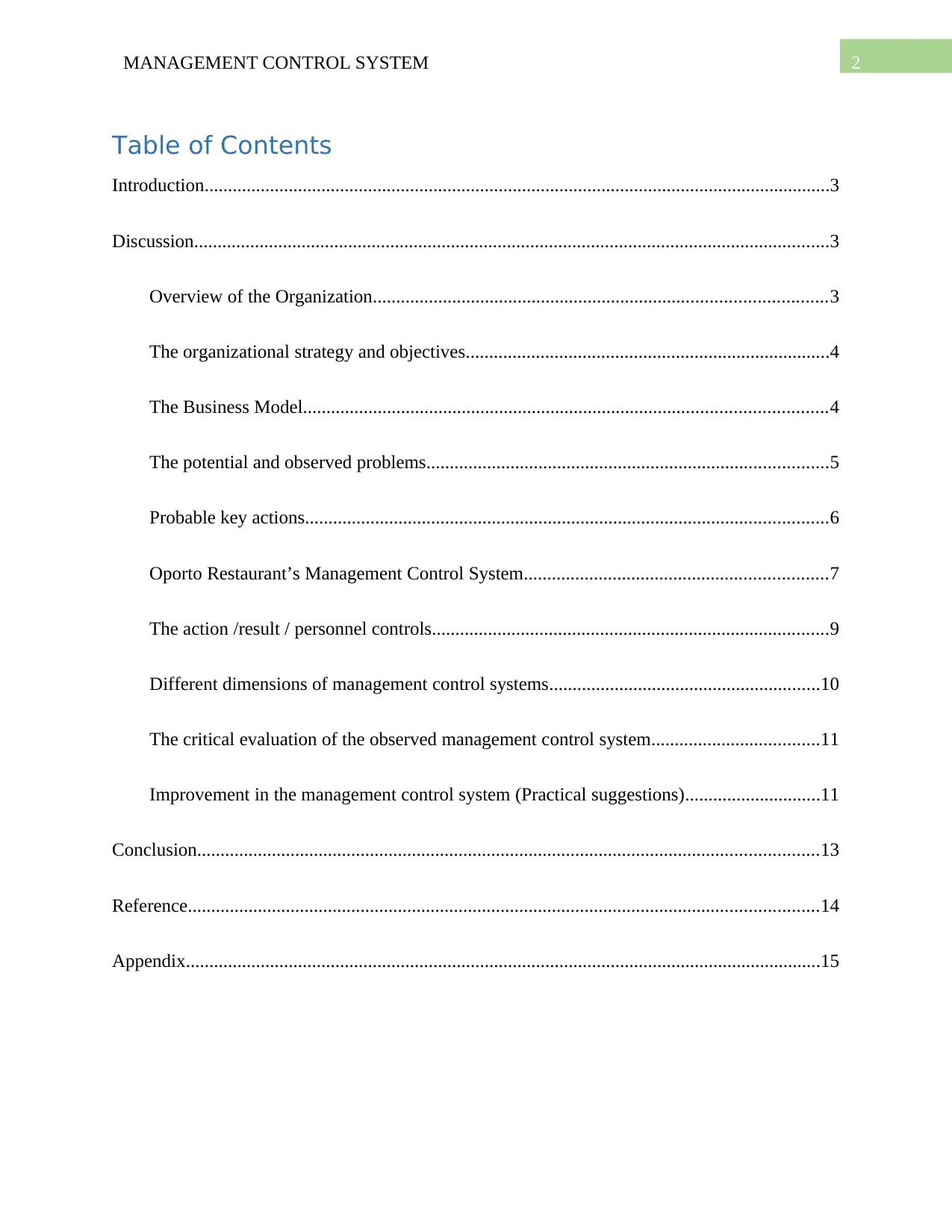
2MANAGEMENT CONTROL SYSTEM
Table of Contents
Introduction......................................................................................................................................3
Discussion........................................................................................................................................3
Overview of the Organization.................................................................................................3
The organizational strategy and objectives..............................................................................4
The Business Model................................................................................................................4
The potential and observed problems......................................................................................5
Probable key actions................................................................................................................6
Oporto Restaurant’s Management Control System.................................................................7
The action /result / personnel controls.....................................................................................9
Different dimensions of management control systems..........................................................10
The critical evaluation of the observed management control system....................................11
Improvement in the management control system (Practical suggestions).............................11
Conclusion.....................................................................................................................................13
Reference.......................................................................................................................................14
Appendix........................................................................................................................................15
Table of Contents
Introduction......................................................................................................................................3
Discussion........................................................................................................................................3
Overview of the Organization.................................................................................................3
The organizational strategy and objectives..............................................................................4
The Business Model................................................................................................................4
The potential and observed problems......................................................................................5
Probable key actions................................................................................................................6
Oporto Restaurant’s Management Control System.................................................................7
The action /result / personnel controls.....................................................................................9
Different dimensions of management control systems..........................................................10
The critical evaluation of the observed management control system....................................11
Improvement in the management control system (Practical suggestions).............................11
Conclusion.....................................................................................................................................13
Reference.......................................................................................................................................14
Appendix........................................................................................................................................15
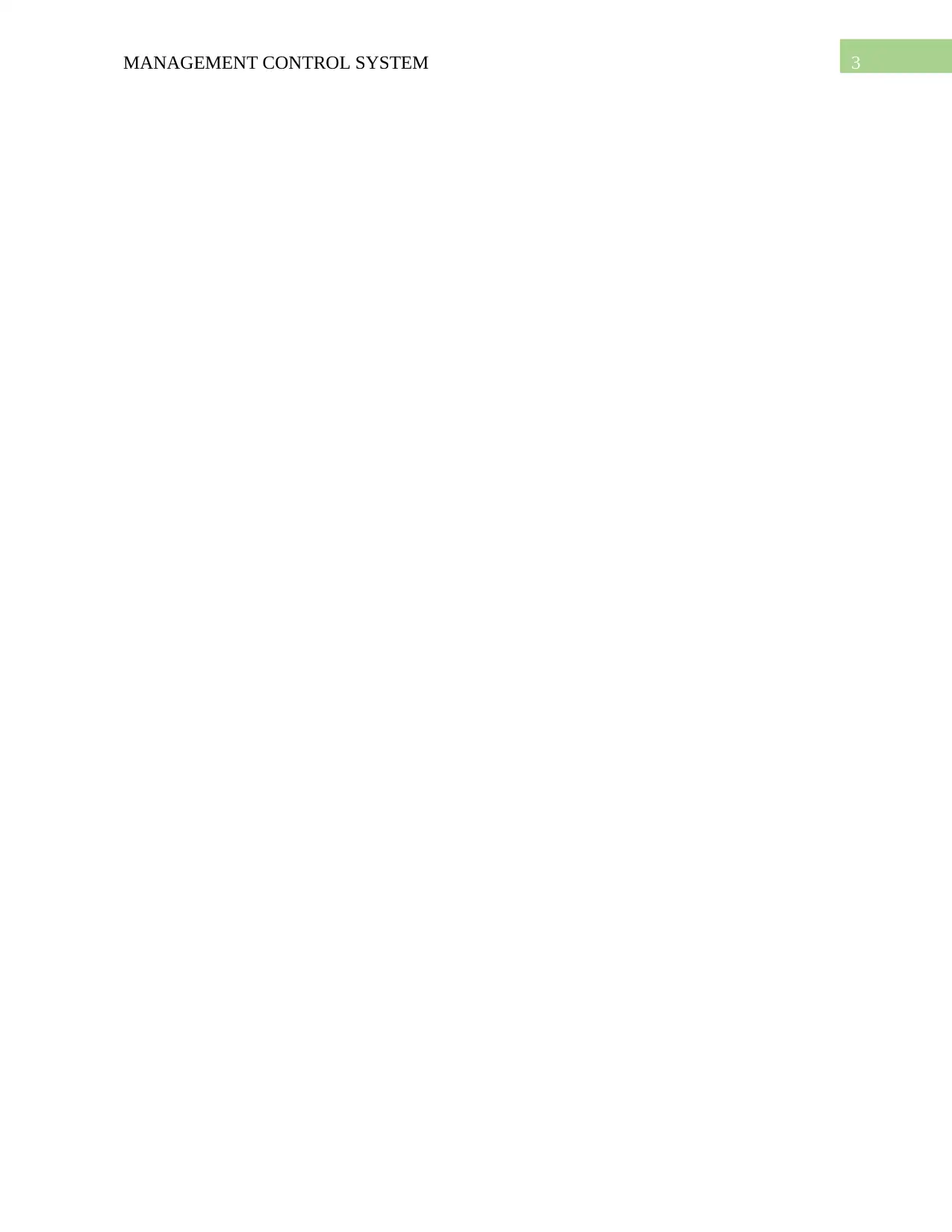
3MANAGEMENT CONTROL SYSTEM
Secure Best Marks with AI Grader
Need help grading? Try our AI Grader for instant feedback on your assignments.
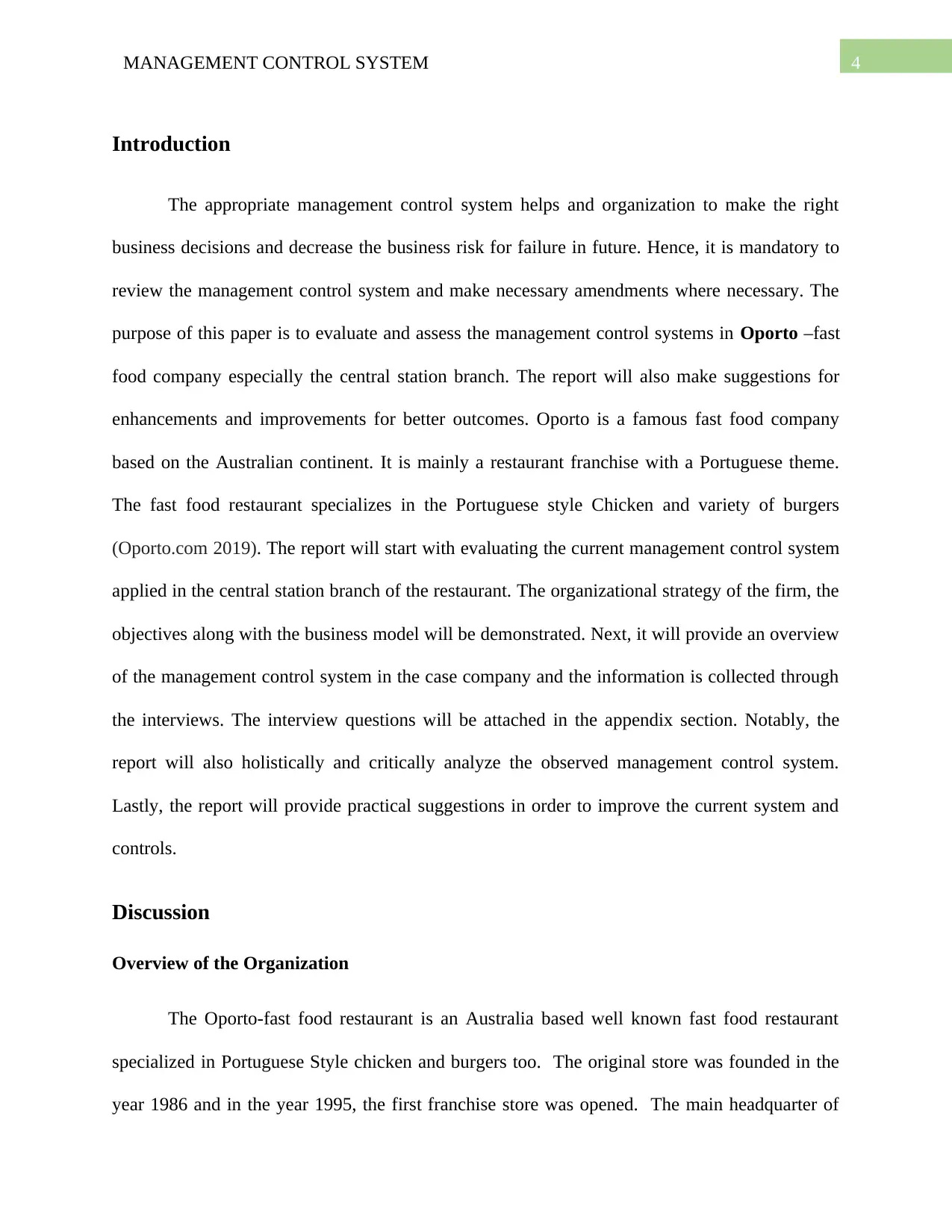
4MANAGEMENT CONTROL SYSTEM
Introduction
The appropriate management control system helps and organization to make the right
business decisions and decrease the business risk for failure in future. Hence, it is mandatory to
review the management control system and make necessary amendments where necessary. The
purpose of this paper is to evaluate and assess the management control systems in Oporto –fast
food company especially the central station branch. The report will also make suggestions for
enhancements and improvements for better outcomes. Oporto is a famous fast food company
based on the Australian continent. It is mainly a restaurant franchise with a Portuguese theme.
The fast food restaurant specializes in the Portuguese style Chicken and variety of burgers
(Oporto.com 2019). The report will start with evaluating the current management control system
applied in the central station branch of the restaurant. The organizational strategy of the firm, the
objectives along with the business model will be demonstrated. Next, it will provide an overview
of the management control system in the case company and the information is collected through
the interviews. The interview questions will be attached in the appendix section. Notably, the
report will also holistically and critically analyze the observed management control system.
Lastly, the report will provide practical suggestions in order to improve the current system and
controls.
Discussion
Overview of the Organization
The Oporto-fast food restaurant is an Australia based well known fast food restaurant
specialized in Portuguese Style chicken and burgers too. The original store was founded in the
year 1986 and in the year 1995, the first franchise store was opened. The main headquarter of
Introduction
The appropriate management control system helps and organization to make the right
business decisions and decrease the business risk for failure in future. Hence, it is mandatory to
review the management control system and make necessary amendments where necessary. The
purpose of this paper is to evaluate and assess the management control systems in Oporto –fast
food company especially the central station branch. The report will also make suggestions for
enhancements and improvements for better outcomes. Oporto is a famous fast food company
based on the Australian continent. It is mainly a restaurant franchise with a Portuguese theme.
The fast food restaurant specializes in the Portuguese style Chicken and variety of burgers
(Oporto.com 2019). The report will start with evaluating the current management control system
applied in the central station branch of the restaurant. The organizational strategy of the firm, the
objectives along with the business model will be demonstrated. Next, it will provide an overview
of the management control system in the case company and the information is collected through
the interviews. The interview questions will be attached in the appendix section. Notably, the
report will also holistically and critically analyze the observed management control system.
Lastly, the report will provide practical suggestions in order to improve the current system and
controls.
Discussion
Overview of the Organization
The Oporto-fast food restaurant is an Australia based well known fast food restaurant
specialized in Portuguese Style chicken and burgers too. The original store was founded in the
year 1986 and in the year 1995, the first franchise store was opened. The main headquarter of
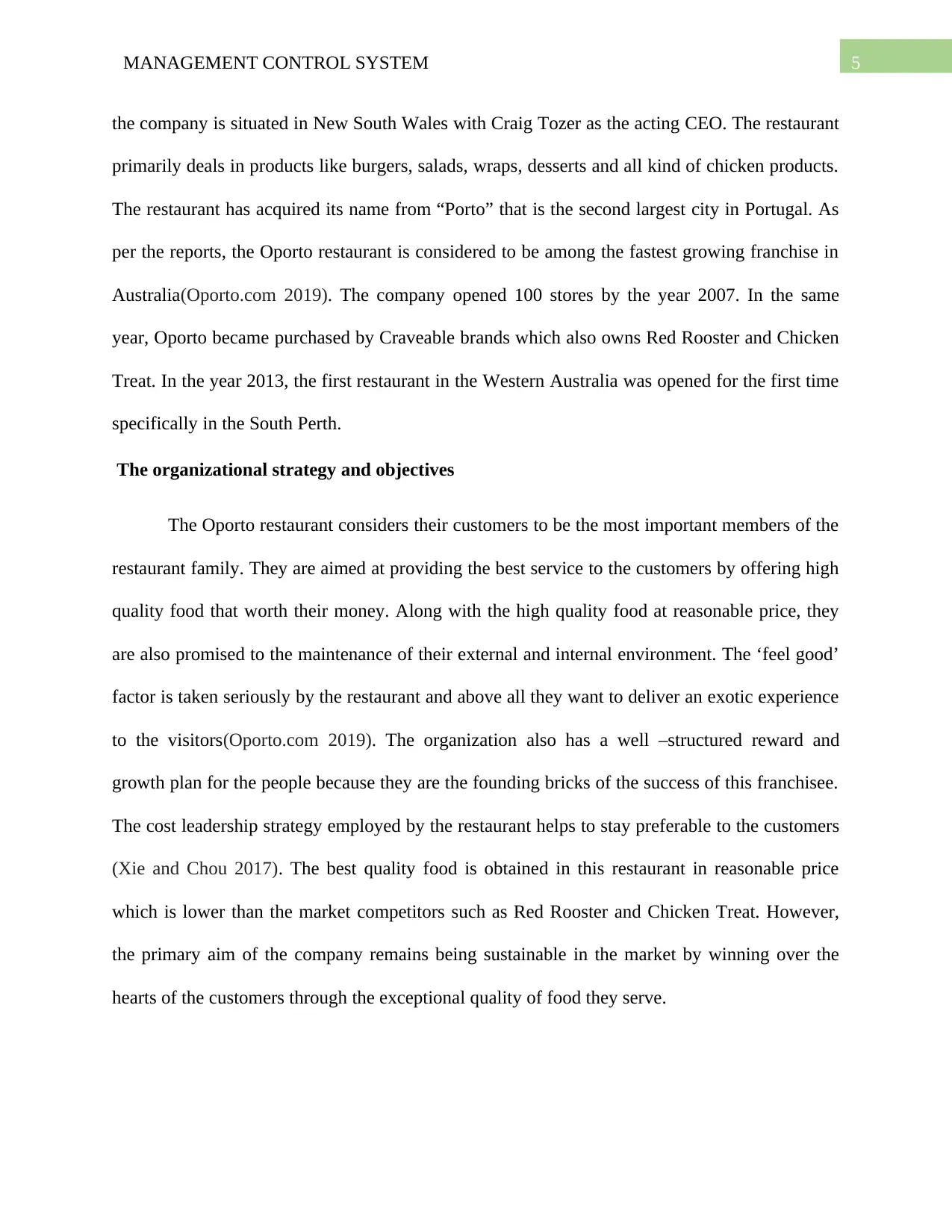
5MANAGEMENT CONTROL SYSTEM
the company is situated in New South Wales with Craig Tozer as the acting CEO. The restaurant
primarily deals in products like burgers, salads, wraps, desserts and all kind of chicken products.
The restaurant has acquired its name from “Porto” that is the second largest city in Portugal. As
per the reports, the Oporto restaurant is considered to be among the fastest growing franchise in
Australia(Oporto.com 2019). The company opened 100 stores by the year 2007. In the same
year, Oporto became purchased by Craveable brands which also owns Red Rooster and Chicken
Treat. In the year 2013, the first restaurant in the Western Australia was opened for the first time
specifically in the South Perth.
The organizational strategy and objectives
The Oporto restaurant considers their customers to be the most important members of the
restaurant family. They are aimed at providing the best service to the customers by offering high
quality food that worth their money. Along with the high quality food at reasonable price, they
are also promised to the maintenance of their external and internal environment. The ‘feel good’
factor is taken seriously by the restaurant and above all they want to deliver an exotic experience
to the visitors(Oporto.com 2019). The organization also has a well –structured reward and
growth plan for the people because they are the founding bricks of the success of this franchisee.
The cost leadership strategy employed by the restaurant helps to stay preferable to the customers
(Xie and Chou 2017). The best quality food is obtained in this restaurant in reasonable price
which is lower than the market competitors such as Red Rooster and Chicken Treat. However,
the primary aim of the company remains being sustainable in the market by winning over the
hearts of the customers through the exceptional quality of food they serve.
the company is situated in New South Wales with Craig Tozer as the acting CEO. The restaurant
primarily deals in products like burgers, salads, wraps, desserts and all kind of chicken products.
The restaurant has acquired its name from “Porto” that is the second largest city in Portugal. As
per the reports, the Oporto restaurant is considered to be among the fastest growing franchise in
Australia(Oporto.com 2019). The company opened 100 stores by the year 2007. In the same
year, Oporto became purchased by Craveable brands which also owns Red Rooster and Chicken
Treat. In the year 2013, the first restaurant in the Western Australia was opened for the first time
specifically in the South Perth.
The organizational strategy and objectives
The Oporto restaurant considers their customers to be the most important members of the
restaurant family. They are aimed at providing the best service to the customers by offering high
quality food that worth their money. Along with the high quality food at reasonable price, they
are also promised to the maintenance of their external and internal environment. The ‘feel good’
factor is taken seriously by the restaurant and above all they want to deliver an exotic experience
to the visitors(Oporto.com 2019). The organization also has a well –structured reward and
growth plan for the people because they are the founding bricks of the success of this franchisee.
The cost leadership strategy employed by the restaurant helps to stay preferable to the customers
(Xie and Chou 2017). The best quality food is obtained in this restaurant in reasonable price
which is lower than the market competitors such as Red Rooster and Chicken Treat. However,
the primary aim of the company remains being sustainable in the market by winning over the
hearts of the customers through the exceptional quality of food they serve.
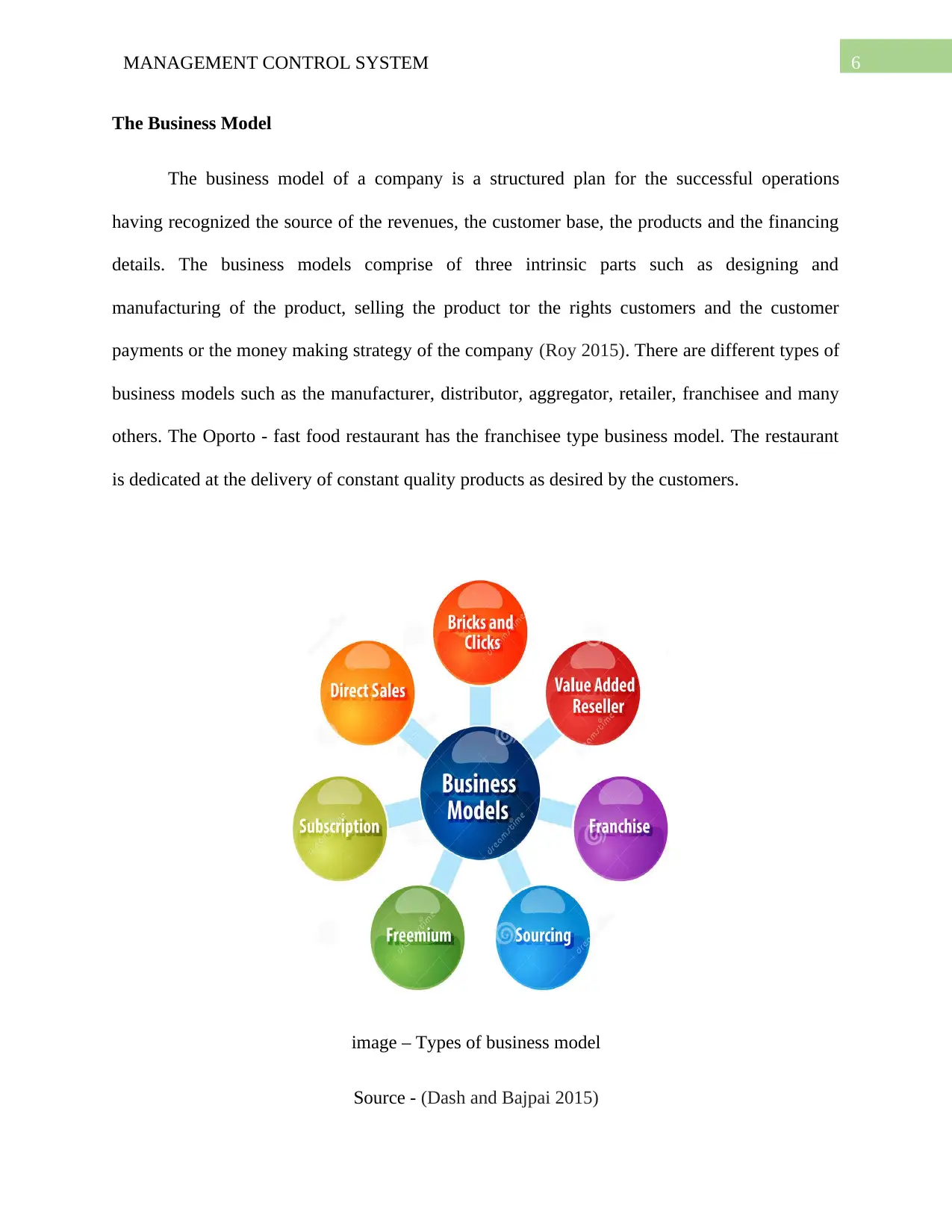
6MANAGEMENT CONTROL SYSTEM
The Business Model
The business model of a company is a structured plan for the successful operations
having recognized the source of the revenues, the customer base, the products and the financing
details. The business models comprise of three intrinsic parts such as designing and
manufacturing of the product, selling the product tor the rights customers and the customer
payments or the money making strategy of the company (Roy 2015). There are different types of
business models such as the manufacturer, distributor, aggregator, retailer, franchisee and many
others. The Oporto - fast food restaurant has the franchisee type business model. The restaurant
is dedicated at the delivery of constant quality products as desired by the customers.
image – Types of business model
Source - (Dash and Bajpai 2015)
The Business Model
The business model of a company is a structured plan for the successful operations
having recognized the source of the revenues, the customer base, the products and the financing
details. The business models comprise of three intrinsic parts such as designing and
manufacturing of the product, selling the product tor the rights customers and the customer
payments or the money making strategy of the company (Roy 2015). There are different types of
business models such as the manufacturer, distributor, aggregator, retailer, franchisee and many
others. The Oporto - fast food restaurant has the franchisee type business model. The restaurant
is dedicated at the delivery of constant quality products as desired by the customers.
image – Types of business model
Source - (Dash and Bajpai 2015)
Paraphrase This Document
Need a fresh take? Get an instant paraphrase of this document with our AI Paraphraser
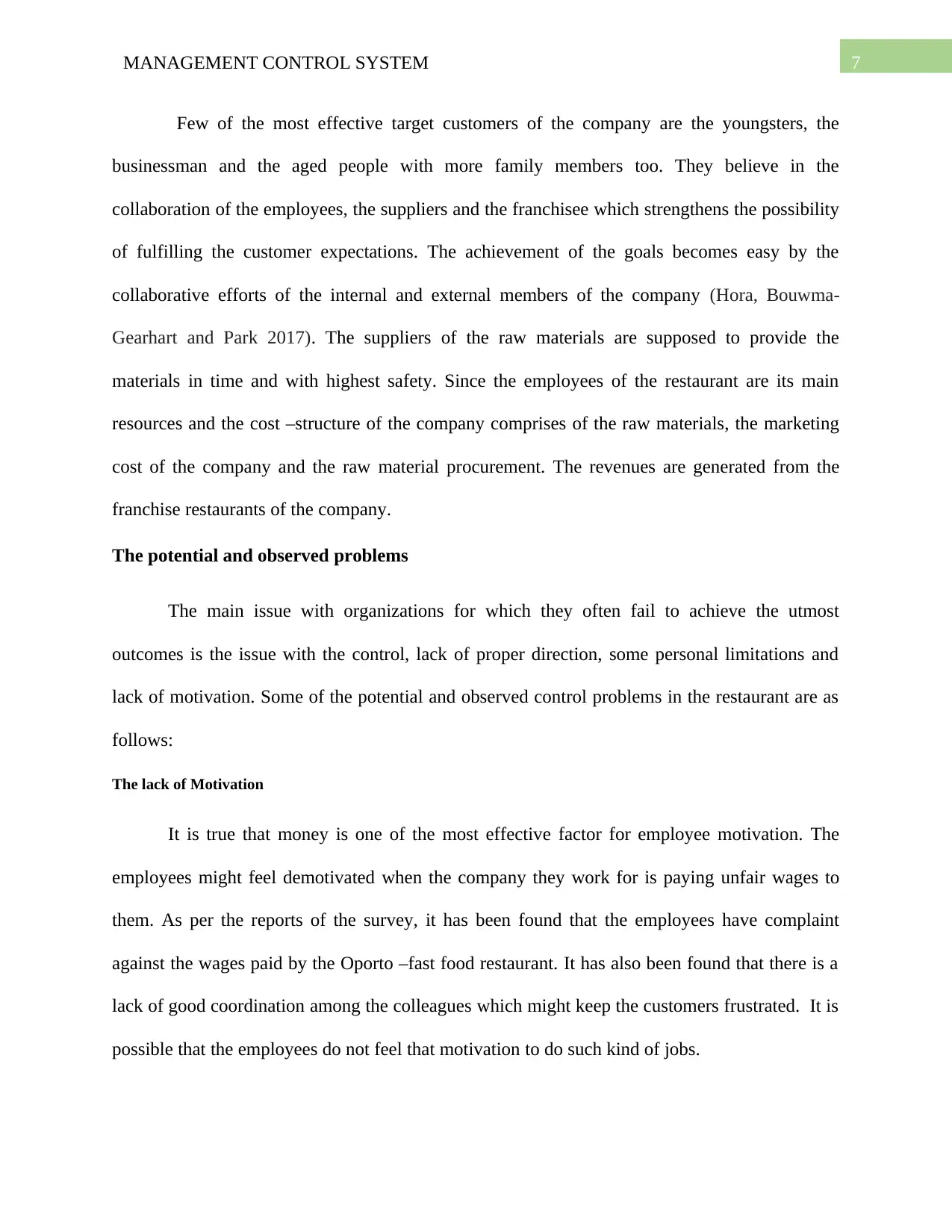
7MANAGEMENT CONTROL SYSTEM
Few of the most effective target customers of the company are the youngsters, the
businessman and the aged people with more family members too. They believe in the
collaboration of the employees, the suppliers and the franchisee which strengthens the possibility
of fulfilling the customer expectations. The achievement of the goals becomes easy by the
collaborative efforts of the internal and external members of the company (Hora, Bouwma-
Gearhart and Park 2017). The suppliers of the raw materials are supposed to provide the
materials in time and with highest safety. Since the employees of the restaurant are its main
resources and the cost –structure of the company comprises of the raw materials, the marketing
cost of the company and the raw material procurement. The revenues are generated from the
franchise restaurants of the company.
The potential and observed problems
The main issue with organizations for which they often fail to achieve the utmost
outcomes is the issue with the control, lack of proper direction, some personal limitations and
lack of motivation. Some of the potential and observed control problems in the restaurant are as
follows:
The lack of Motivation
It is true that money is one of the most effective factor for employee motivation. The
employees might feel demotivated when the company they work for is paying unfair wages to
them. As per the reports of the survey, it has been found that the employees have complaint
against the wages paid by the Oporto –fast food restaurant. It has also been found that there is a
lack of good coordination among the colleagues which might keep the customers frustrated. It is
possible that the employees do not feel that motivation to do such kind of jobs.
Few of the most effective target customers of the company are the youngsters, the
businessman and the aged people with more family members too. They believe in the
collaboration of the employees, the suppliers and the franchisee which strengthens the possibility
of fulfilling the customer expectations. The achievement of the goals becomes easy by the
collaborative efforts of the internal and external members of the company (Hora, Bouwma-
Gearhart and Park 2017). The suppliers of the raw materials are supposed to provide the
materials in time and with highest safety. Since the employees of the restaurant are its main
resources and the cost –structure of the company comprises of the raw materials, the marketing
cost of the company and the raw material procurement. The revenues are generated from the
franchise restaurants of the company.
The potential and observed problems
The main issue with organizations for which they often fail to achieve the utmost
outcomes is the issue with the control, lack of proper direction, some personal limitations and
lack of motivation. Some of the potential and observed control problems in the restaurant are as
follows:
The lack of Motivation
It is true that money is one of the most effective factor for employee motivation. The
employees might feel demotivated when the company they work for is paying unfair wages to
them. As per the reports of the survey, it has been found that the employees have complaint
against the wages paid by the Oporto –fast food restaurant. It has also been found that there is a
lack of good coordination among the colleagues which might keep the customers frustrated. It is
possible that the employees do not feel that motivation to do such kind of jobs.
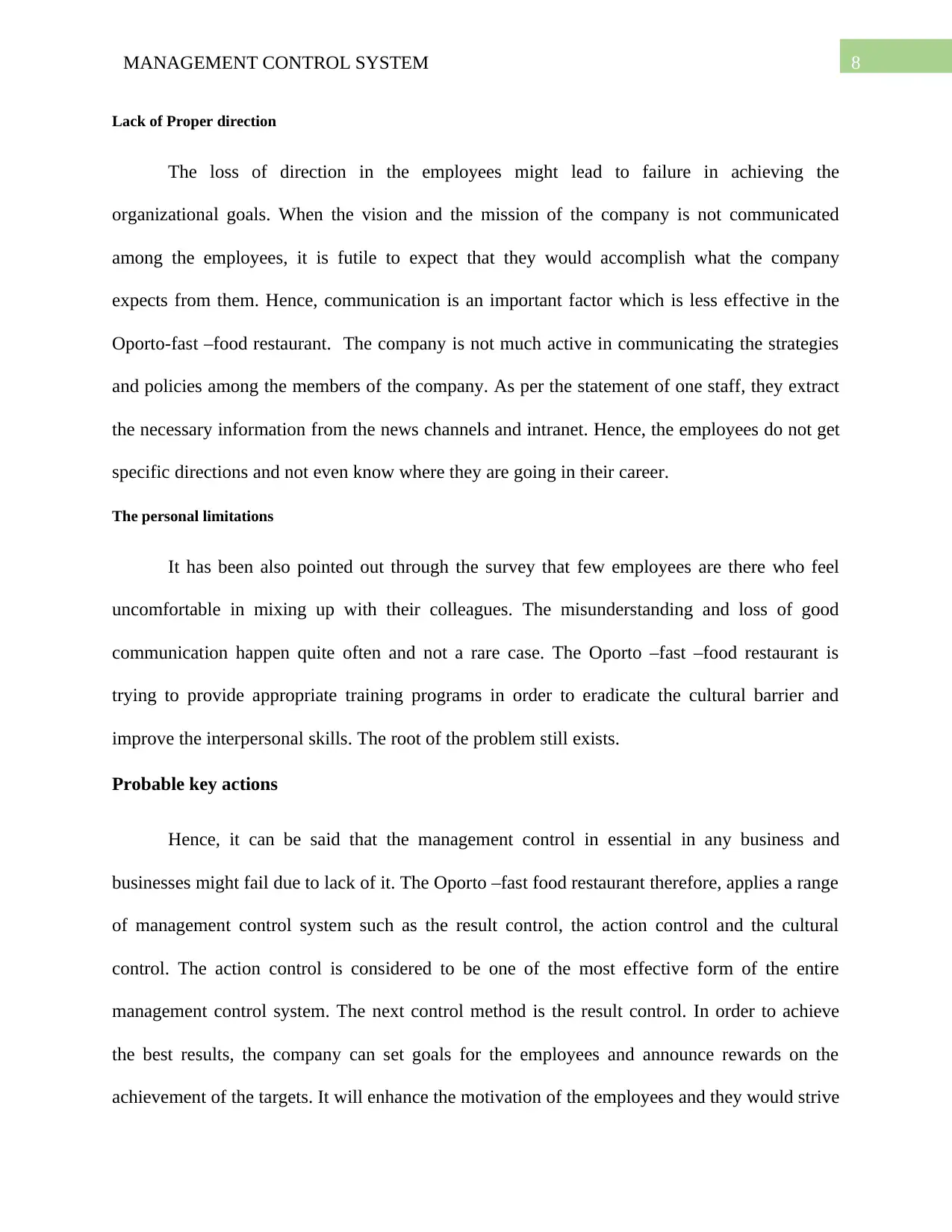
8MANAGEMENT CONTROL SYSTEM
Lack of Proper direction
The loss of direction in the employees might lead to failure in achieving the
organizational goals. When the vision and the mission of the company is not communicated
among the employees, it is futile to expect that they would accomplish what the company
expects from them. Hence, communication is an important factor which is less effective in the
Oporto-fast –food restaurant. The company is not much active in communicating the strategies
and policies among the members of the company. As per the statement of one staff, they extract
the necessary information from the news channels and intranet. Hence, the employees do not get
specific directions and not even know where they are going in their career.
The personal limitations
It has been also pointed out through the survey that few employees are there who feel
uncomfortable in mixing up with their colleagues. The misunderstanding and loss of good
communication happen quite often and not a rare case. The Oporto –fast –food restaurant is
trying to provide appropriate training programs in order to eradicate the cultural barrier and
improve the interpersonal skills. The root of the problem still exists.
Probable key actions
Hence, it can be said that the management control in essential in any business and
businesses might fail due to lack of it. The Oporto –fast food restaurant therefore, applies a range
of management control system such as the result control, the action control and the cultural
control. The action control is considered to be one of the most effective form of the entire
management control system. The next control method is the result control. In order to achieve
the best results, the company can set goals for the employees and announce rewards on the
achievement of the targets. It will enhance the motivation of the employees and they would strive
Lack of Proper direction
The loss of direction in the employees might lead to failure in achieving the
organizational goals. When the vision and the mission of the company is not communicated
among the employees, it is futile to expect that they would accomplish what the company
expects from them. Hence, communication is an important factor which is less effective in the
Oporto-fast –food restaurant. The company is not much active in communicating the strategies
and policies among the members of the company. As per the statement of one staff, they extract
the necessary information from the news channels and intranet. Hence, the employees do not get
specific directions and not even know where they are going in their career.
The personal limitations
It has been also pointed out through the survey that few employees are there who feel
uncomfortable in mixing up with their colleagues. The misunderstanding and loss of good
communication happen quite often and not a rare case. The Oporto –fast –food restaurant is
trying to provide appropriate training programs in order to eradicate the cultural barrier and
improve the interpersonal skills. The root of the problem still exists.
Probable key actions
Hence, it can be said that the management control in essential in any business and
businesses might fail due to lack of it. The Oporto –fast food restaurant therefore, applies a range
of management control system such as the result control, the action control and the cultural
control. The action control is considered to be one of the most effective form of the entire
management control system. The next control method is the result control. In order to achieve
the best results, the company can set goals for the employees and announce rewards on the
achievement of the targets. It will enhance the motivation of the employees and they would strive
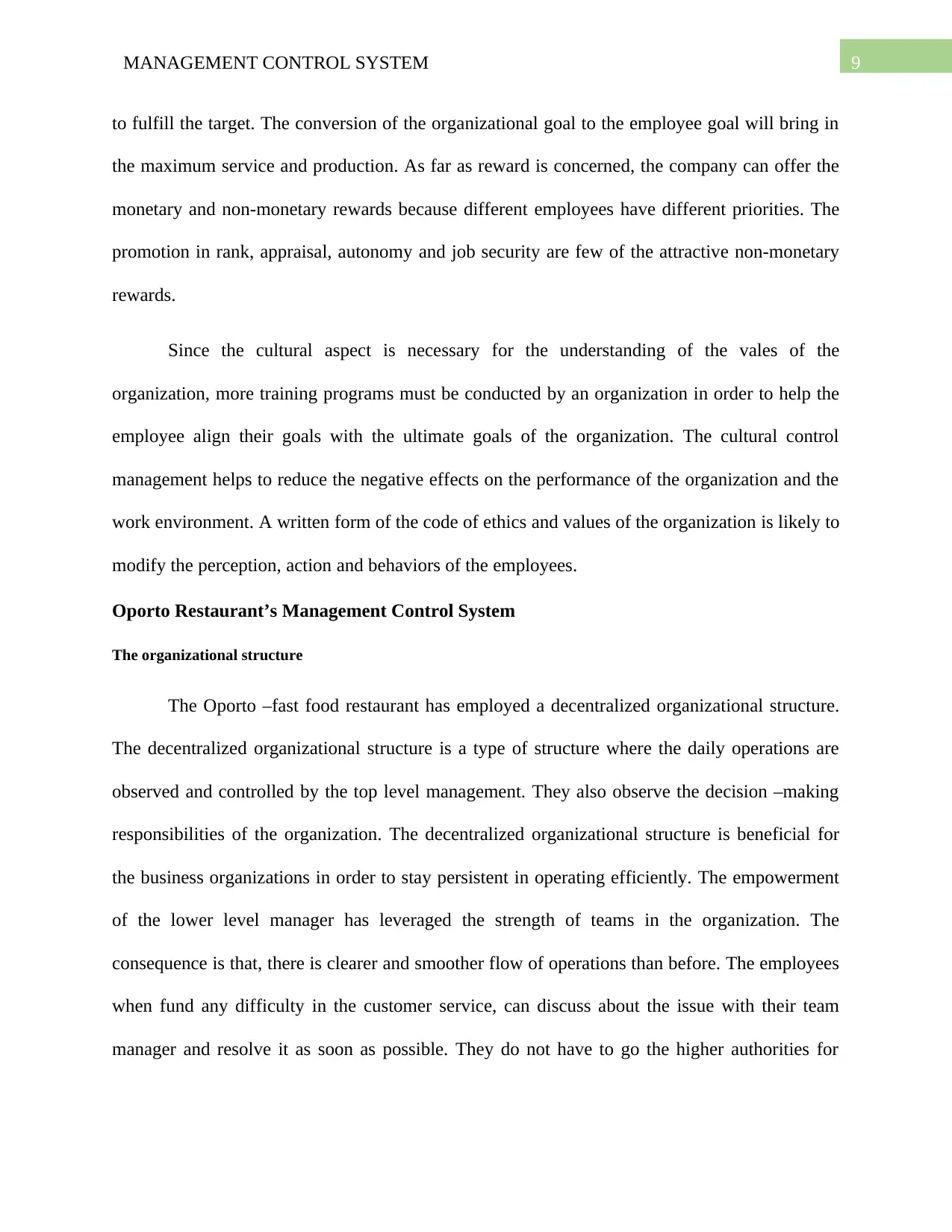
9MANAGEMENT CONTROL SYSTEM
to fulfill the target. The conversion of the organizational goal to the employee goal will bring in
the maximum service and production. As far as reward is concerned, the company can offer the
monetary and non-monetary rewards because different employees have different priorities. The
promotion in rank, appraisal, autonomy and job security are few of the attractive non-monetary
rewards.
Since the cultural aspect is necessary for the understanding of the vales of the
organization, more training programs must be conducted by an organization in order to help the
employee align their goals with the ultimate goals of the organization. The cultural control
management helps to reduce the negative effects on the performance of the organization and the
work environment. A written form of the code of ethics and values of the organization is likely to
modify the perception, action and behaviors of the employees.
Oporto Restaurant’s Management Control System
The organizational structure
The Oporto –fast food restaurant has employed a decentralized organizational structure.
The decentralized organizational structure is a type of structure where the daily operations are
observed and controlled by the top level management. They also observe the decision –making
responsibilities of the organization. The decentralized organizational structure is beneficial for
the business organizations in order to stay persistent in operating efficiently. The empowerment
of the lower level manager has leveraged the strength of teams in the organization. The
consequence is that, there is clearer and smoother flow of operations than before. The employees
when fund any difficulty in the customer service, can discuss about the issue with their team
manager and resolve it as soon as possible. They do not have to go the higher authorities for
to fulfill the target. The conversion of the organizational goal to the employee goal will bring in
the maximum service and production. As far as reward is concerned, the company can offer the
monetary and non-monetary rewards because different employees have different priorities. The
promotion in rank, appraisal, autonomy and job security are few of the attractive non-monetary
rewards.
Since the cultural aspect is necessary for the understanding of the vales of the
organization, more training programs must be conducted by an organization in order to help the
employee align their goals with the ultimate goals of the organization. The cultural control
management helps to reduce the negative effects on the performance of the organization and the
work environment. A written form of the code of ethics and values of the organization is likely to
modify the perception, action and behaviors of the employees.
Oporto Restaurant’s Management Control System
The organizational structure
The Oporto –fast food restaurant has employed a decentralized organizational structure.
The decentralized organizational structure is a type of structure where the daily operations are
observed and controlled by the top level management. They also observe the decision –making
responsibilities of the organization. The decentralized organizational structure is beneficial for
the business organizations in order to stay persistent in operating efficiently. The empowerment
of the lower level manager has leveraged the strength of teams in the organization. The
consequence is that, there is clearer and smoother flow of operations than before. The employees
when fund any difficulty in the customer service, can discuss about the issue with their team
manager and resolve it as soon as possible. They do not have to go the higher authorities for
Secure Best Marks with AI Grader
Need help grading? Try our AI Grader for instant feedback on your assignments.
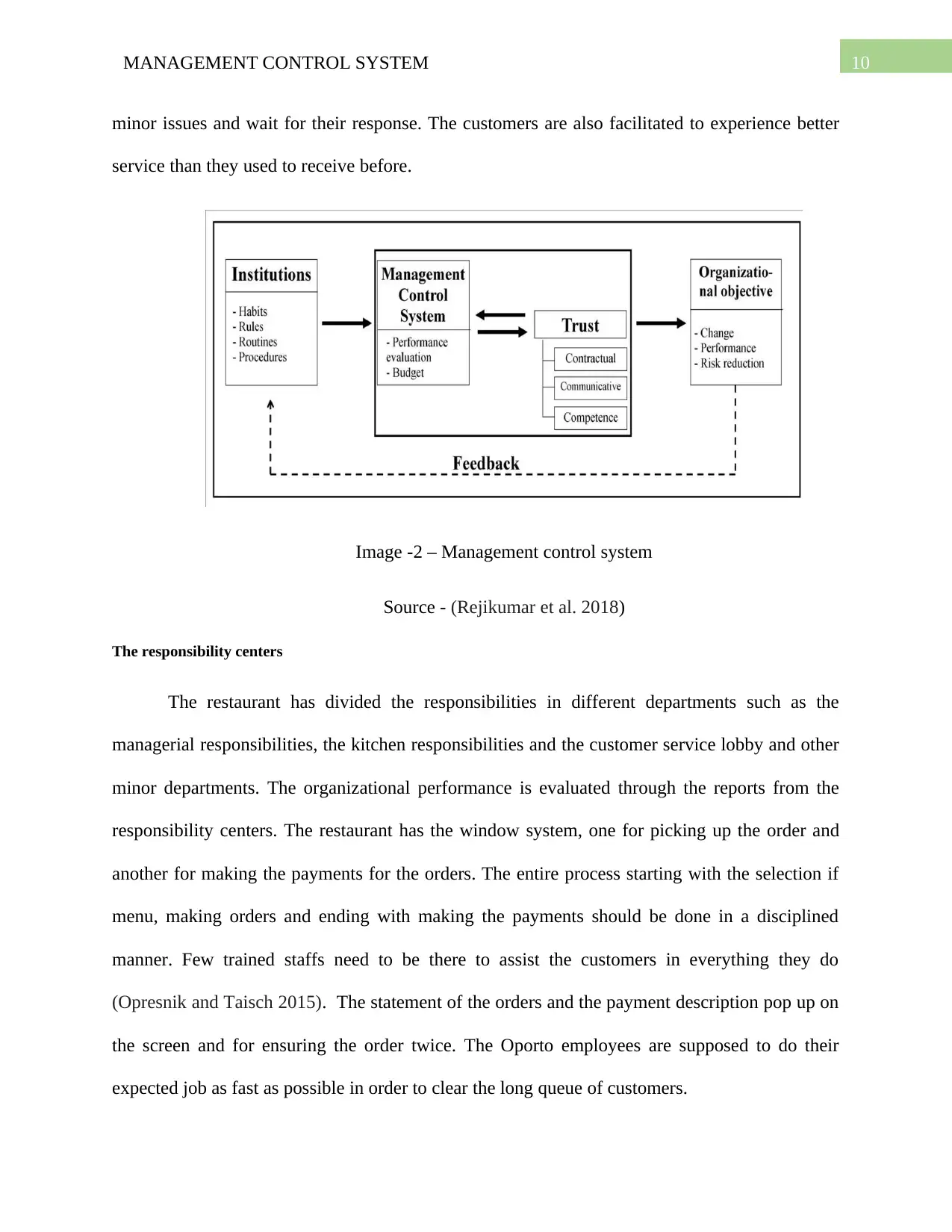
10MANAGEMENT CONTROL SYSTEM
minor issues and wait for their response. The customers are also facilitated to experience better
service than they used to receive before.
Image -2 – Management control system
Source - (Rejikumar et al. 2018)
The responsibility centers
The restaurant has divided the responsibilities in different departments such as the
managerial responsibilities, the kitchen responsibilities and the customer service lobby and other
minor departments. The organizational performance is evaluated through the reports from the
responsibility centers. The restaurant has the window system, one for picking up the order and
another for making the payments for the orders. The entire process starting with the selection if
menu, making orders and ending with making the payments should be done in a disciplined
manner. Few trained staffs need to be there to assist the customers in everything they do
(Opresnik and Taisch 2015). The statement of the orders and the payment description pop up on
the screen and for ensuring the order twice. The Oporto employees are supposed to do their
expected job as fast as possible in order to clear the long queue of customers.
minor issues and wait for their response. The customers are also facilitated to experience better
service than they used to receive before.
Image -2 – Management control system
Source - (Rejikumar et al. 2018)
The responsibility centers
The restaurant has divided the responsibilities in different departments such as the
managerial responsibilities, the kitchen responsibilities and the customer service lobby and other
minor departments. The organizational performance is evaluated through the reports from the
responsibility centers. The restaurant has the window system, one for picking up the order and
another for making the payments for the orders. The entire process starting with the selection if
menu, making orders and ending with making the payments should be done in a disciplined
manner. Few trained staffs need to be there to assist the customers in everything they do
(Opresnik and Taisch 2015). The statement of the orders and the payment description pop up on
the screen and for ensuring the order twice. The Oporto employees are supposed to do their
expected job as fast as possible in order to clear the long queue of customers.
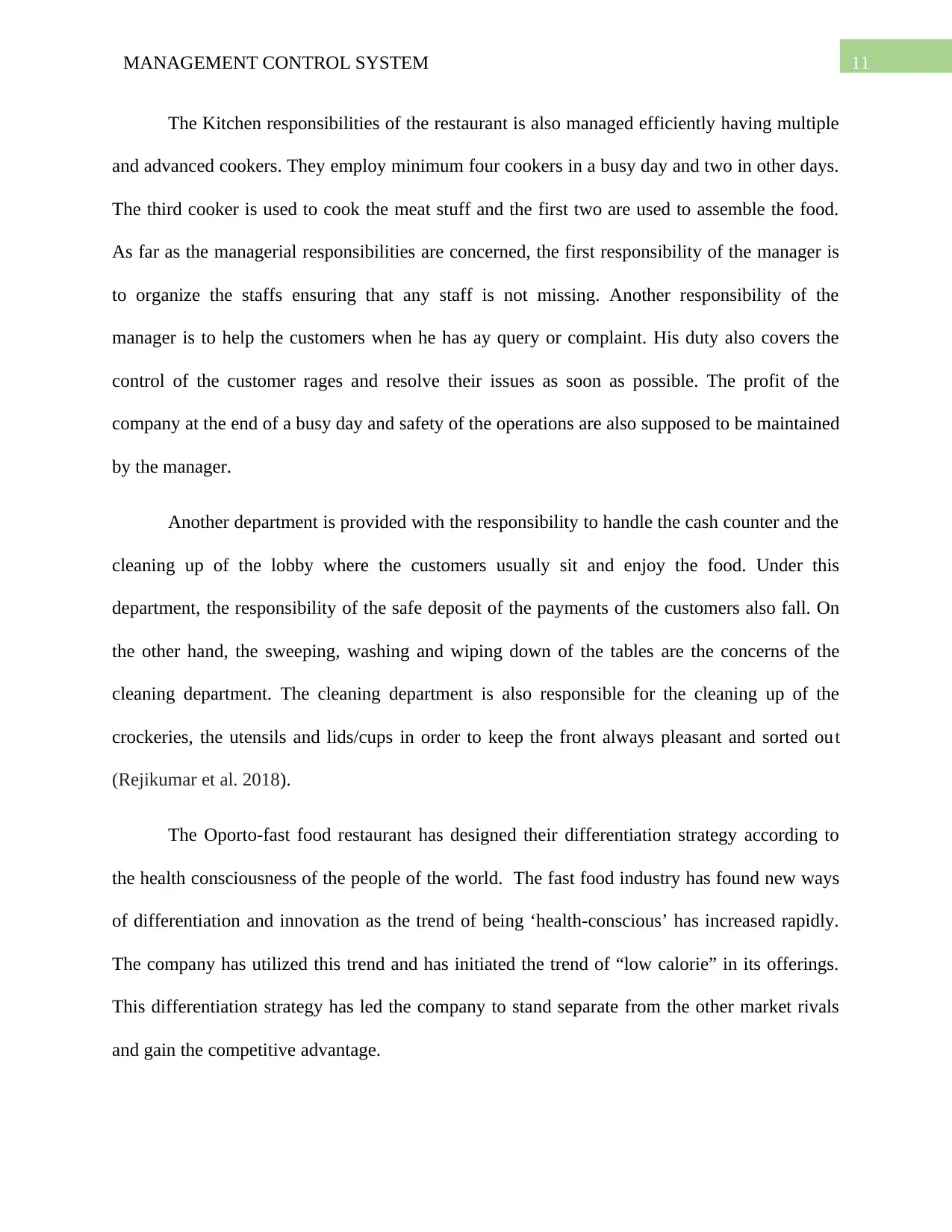
11MANAGEMENT CONTROL SYSTEM
The Kitchen responsibilities of the restaurant is also managed efficiently having multiple
and advanced cookers. They employ minimum four cookers in a busy day and two in other days.
The third cooker is used to cook the meat stuff and the first two are used to assemble the food.
As far as the managerial responsibilities are concerned, the first responsibility of the manager is
to organize the staffs ensuring that any staff is not missing. Another responsibility of the
manager is to help the customers when he has ay query or complaint. His duty also covers the
control of the customer rages and resolve their issues as soon as possible. The profit of the
company at the end of a busy day and safety of the operations are also supposed to be maintained
by the manager.
Another department is provided with the responsibility to handle the cash counter and the
cleaning up of the lobby where the customers usually sit and enjoy the food. Under this
department, the responsibility of the safe deposit of the payments of the customers also fall. On
the other hand, the sweeping, washing and wiping down of the tables are the concerns of the
cleaning department. The cleaning department is also responsible for the cleaning up of the
crockeries, the utensils and lids/cups in order to keep the front always pleasant and sorted out
(Rejikumar et al. 2018).
The Oporto-fast food restaurant has designed their differentiation strategy according to
the health consciousness of the people of the world. The fast food industry has found new ways
of differentiation and innovation as the trend of being ‘health-conscious’ has increased rapidly.
The company has utilized this trend and has initiated the trend of “low calorie” in its offerings.
This differentiation strategy has led the company to stand separate from the other market rivals
and gain the competitive advantage.
The Kitchen responsibilities of the restaurant is also managed efficiently having multiple
and advanced cookers. They employ minimum four cookers in a busy day and two in other days.
The third cooker is used to cook the meat stuff and the first two are used to assemble the food.
As far as the managerial responsibilities are concerned, the first responsibility of the manager is
to organize the staffs ensuring that any staff is not missing. Another responsibility of the
manager is to help the customers when he has ay query or complaint. His duty also covers the
control of the customer rages and resolve their issues as soon as possible. The profit of the
company at the end of a busy day and safety of the operations are also supposed to be maintained
by the manager.
Another department is provided with the responsibility to handle the cash counter and the
cleaning up of the lobby where the customers usually sit and enjoy the food. Under this
department, the responsibility of the safe deposit of the payments of the customers also fall. On
the other hand, the sweeping, washing and wiping down of the tables are the concerns of the
cleaning department. The cleaning department is also responsible for the cleaning up of the
crockeries, the utensils and lids/cups in order to keep the front always pleasant and sorted out
(Rejikumar et al. 2018).
The Oporto-fast food restaurant has designed their differentiation strategy according to
the health consciousness of the people of the world. The fast food industry has found new ways
of differentiation and innovation as the trend of being ‘health-conscious’ has increased rapidly.
The company has utilized this trend and has initiated the trend of “low calorie” in its offerings.
This differentiation strategy has led the company to stand separate from the other market rivals
and gain the competitive advantage.
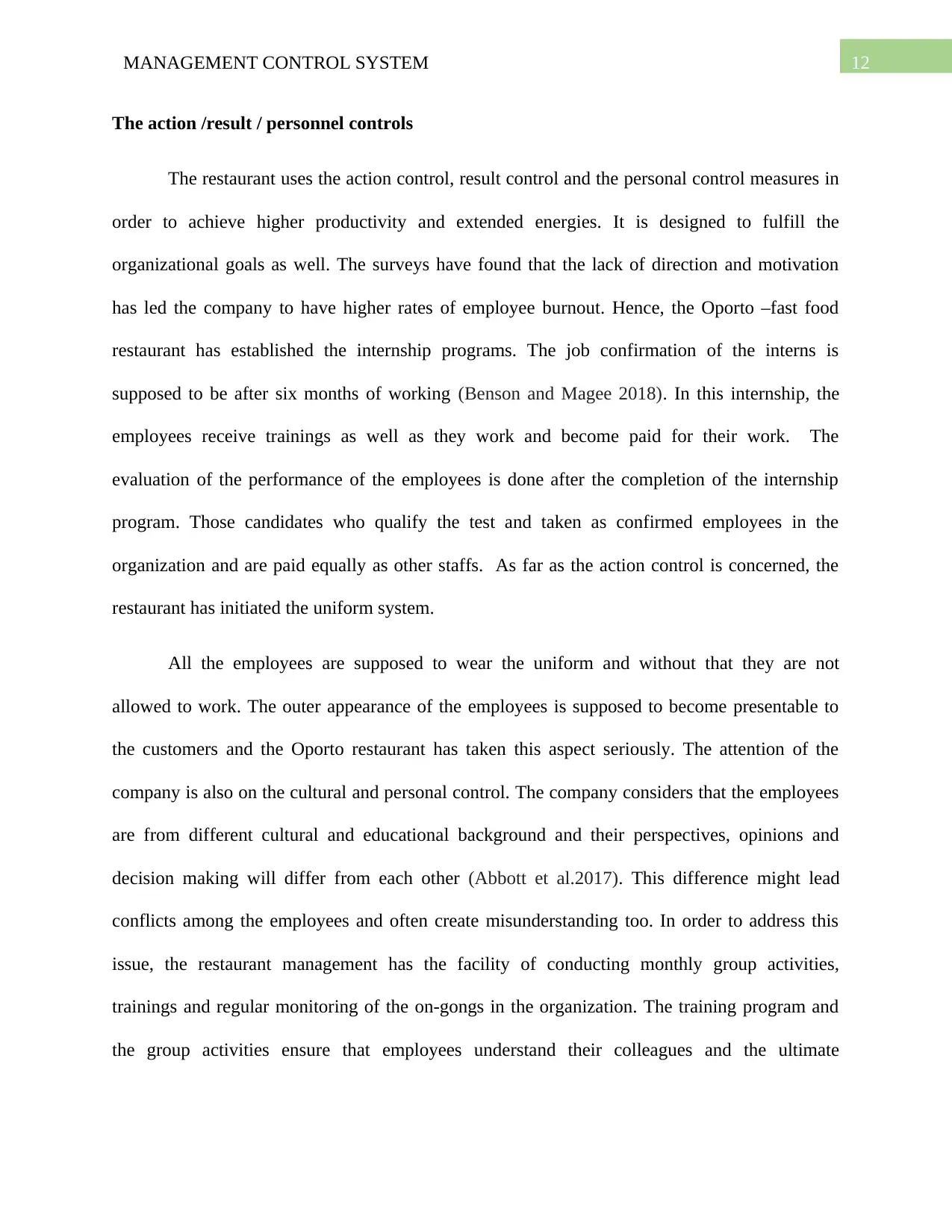
12MANAGEMENT CONTROL SYSTEM
The action /result / personnel controls
The restaurant uses the action control, result control and the personal control measures in
order to achieve higher productivity and extended energies. It is designed to fulfill the
organizational goals as well. The surveys have found that the lack of direction and motivation
has led the company to have higher rates of employee burnout. Hence, the Oporto –fast food
restaurant has established the internship programs. The job confirmation of the interns is
supposed to be after six months of working (Benson and Magee 2018). In this internship, the
employees receive trainings as well as they work and become paid for their work. The
evaluation of the performance of the employees is done after the completion of the internship
program. Those candidates who qualify the test and taken as confirmed employees in the
organization and are paid equally as other staffs. As far as the action control is concerned, the
restaurant has initiated the uniform system.
All the employees are supposed to wear the uniform and without that they are not
allowed to work. The outer appearance of the employees is supposed to become presentable to
the customers and the Oporto restaurant has taken this aspect seriously. The attention of the
company is also on the cultural and personal control. The company considers that the employees
are from different cultural and educational background and their perspectives, opinions and
decision making will differ from each other (Abbott et al.2017). This difference might lead
conflicts among the employees and often create misunderstanding too. In order to address this
issue, the restaurant management has the facility of conducting monthly group activities,
trainings and regular monitoring of the on-gongs in the organization. The training program and
the group activities ensure that employees understand their colleagues and the ultimate
The action /result / personnel controls
The restaurant uses the action control, result control and the personal control measures in
order to achieve higher productivity and extended energies. It is designed to fulfill the
organizational goals as well. The surveys have found that the lack of direction and motivation
has led the company to have higher rates of employee burnout. Hence, the Oporto –fast food
restaurant has established the internship programs. The job confirmation of the interns is
supposed to be after six months of working (Benson and Magee 2018). In this internship, the
employees receive trainings as well as they work and become paid for their work. The
evaluation of the performance of the employees is done after the completion of the internship
program. Those candidates who qualify the test and taken as confirmed employees in the
organization and are paid equally as other staffs. As far as the action control is concerned, the
restaurant has initiated the uniform system.
All the employees are supposed to wear the uniform and without that they are not
allowed to work. The outer appearance of the employees is supposed to become presentable to
the customers and the Oporto restaurant has taken this aspect seriously. The attention of the
company is also on the cultural and personal control. The company considers that the employees
are from different cultural and educational background and their perspectives, opinions and
decision making will differ from each other (Abbott et al.2017). This difference might lead
conflicts among the employees and often create misunderstanding too. In order to address this
issue, the restaurant management has the facility of conducting monthly group activities,
trainings and regular monitoring of the on-gongs in the organization. The training program and
the group activities ensure that employees understand their colleagues and the ultimate
Paraphrase This Document
Need a fresh take? Get an instant paraphrase of this document with our AI Paraphraser
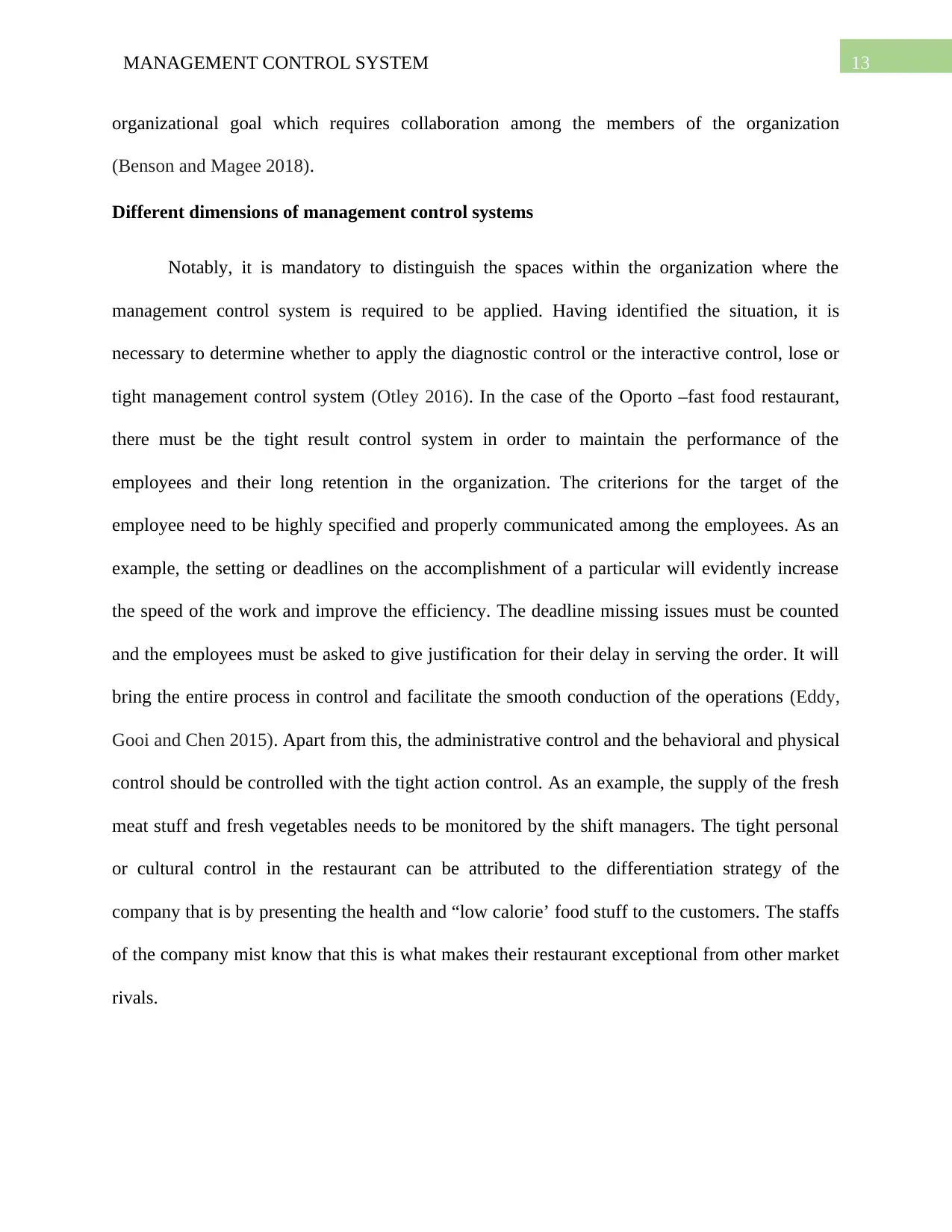
13MANAGEMENT CONTROL SYSTEM
organizational goal which requires collaboration among the members of the organization
(Benson and Magee 2018).
Different dimensions of management control systems
Notably, it is mandatory to distinguish the spaces within the organization where the
management control system is required to be applied. Having identified the situation, it is
necessary to determine whether to apply the diagnostic control or the interactive control, lose or
tight management control system (Otley 2016). In the case of the Oporto –fast food restaurant,
there must be the tight result control system in order to maintain the performance of the
employees and their long retention in the organization. The criterions for the target of the
employee need to be highly specified and properly communicated among the employees. As an
example, the setting or deadlines on the accomplishment of a particular will evidently increase
the speed of the work and improve the efficiency. The deadline missing issues must be counted
and the employees must be asked to give justification for their delay in serving the order. It will
bring the entire process in control and facilitate the smooth conduction of the operations (Eddy,
Gooi and Chen 2015). Apart from this, the administrative control and the behavioral and physical
control should be controlled with the tight action control. As an example, the supply of the fresh
meat stuff and fresh vegetables needs to be monitored by the shift managers. The tight personal
or cultural control in the restaurant can be attributed to the differentiation strategy of the
company that is by presenting the health and “low calorie’ food stuff to the customers. The staffs
of the company mist know that this is what makes their restaurant exceptional from other market
rivals.
organizational goal which requires collaboration among the members of the organization
(Benson and Magee 2018).
Different dimensions of management control systems
Notably, it is mandatory to distinguish the spaces within the organization where the
management control system is required to be applied. Having identified the situation, it is
necessary to determine whether to apply the diagnostic control or the interactive control, lose or
tight management control system (Otley 2016). In the case of the Oporto –fast food restaurant,
there must be the tight result control system in order to maintain the performance of the
employees and their long retention in the organization. The criterions for the target of the
employee need to be highly specified and properly communicated among the employees. As an
example, the setting or deadlines on the accomplishment of a particular will evidently increase
the speed of the work and improve the efficiency. The deadline missing issues must be counted
and the employees must be asked to give justification for their delay in serving the order. It will
bring the entire process in control and facilitate the smooth conduction of the operations (Eddy,
Gooi and Chen 2015). Apart from this, the administrative control and the behavioral and physical
control should be controlled with the tight action control. As an example, the supply of the fresh
meat stuff and fresh vegetables needs to be monitored by the shift managers. The tight personal
or cultural control in the restaurant can be attributed to the differentiation strategy of the
company that is by presenting the health and “low calorie’ food stuff to the customers. The staffs
of the company mist know that this is what makes their restaurant exceptional from other market
rivals.
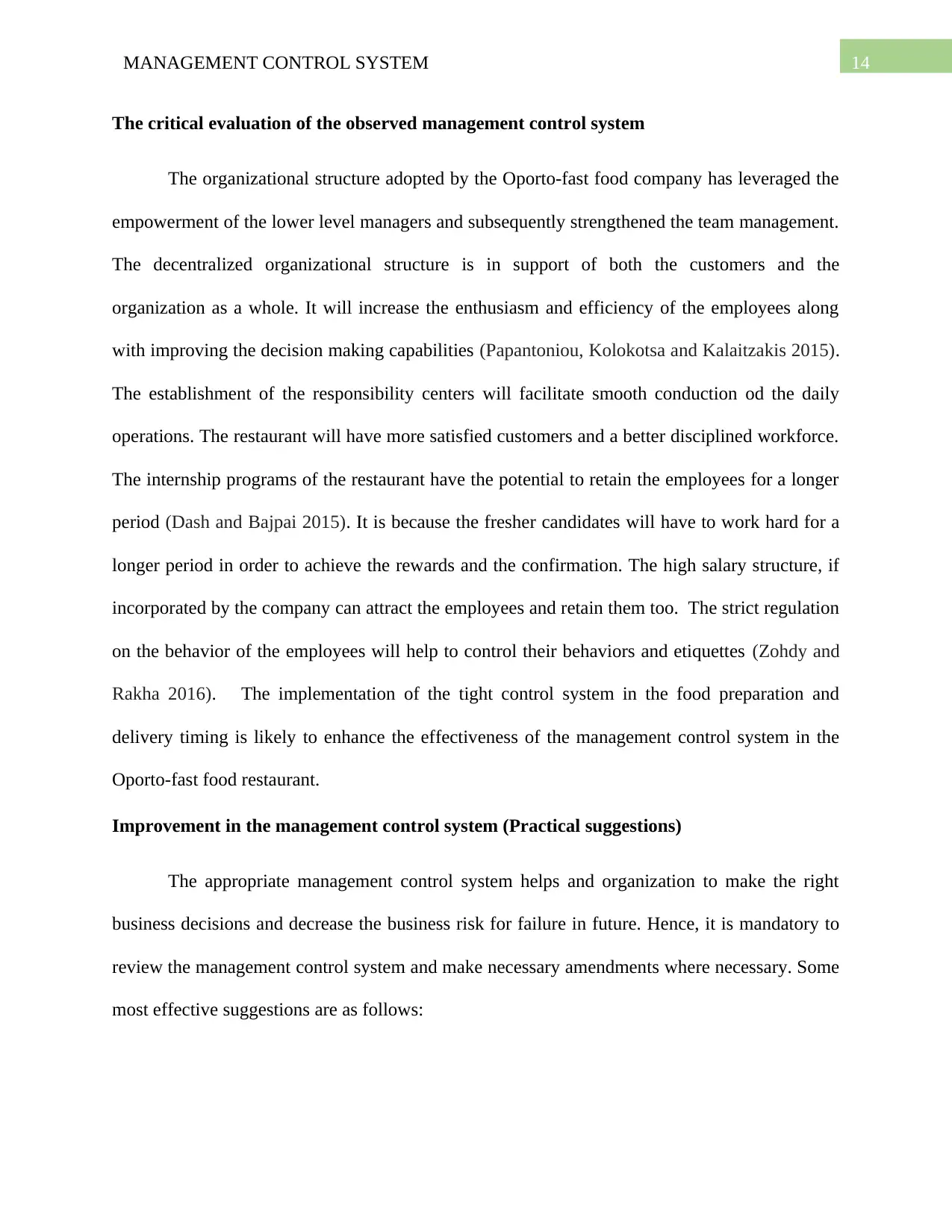
14MANAGEMENT CONTROL SYSTEM
The critical evaluation of the observed management control system
The organizational structure adopted by the Oporto-fast food company has leveraged the
empowerment of the lower level managers and subsequently strengthened the team management.
The decentralized organizational structure is in support of both the customers and the
organization as a whole. It will increase the enthusiasm and efficiency of the employees along
with improving the decision making capabilities (Papantoniou, Kolokotsa and Kalaitzakis 2015).
The establishment of the responsibility centers will facilitate smooth conduction od the daily
operations. The restaurant will have more satisfied customers and a better disciplined workforce.
The internship programs of the restaurant have the potential to retain the employees for a longer
period (Dash and Bajpai 2015). It is because the fresher candidates will have to work hard for a
longer period in order to achieve the rewards and the confirmation. The high salary structure, if
incorporated by the company can attract the employees and retain them too. The strict regulation
on the behavior of the employees will help to control their behaviors and etiquettes (Zohdy and
Rakha 2016). The implementation of the tight control system in the food preparation and
delivery timing is likely to enhance the effectiveness of the management control system in the
Oporto-fast food restaurant.
Improvement in the management control system (Practical suggestions)
The appropriate management control system helps and organization to make the right
business decisions and decrease the business risk for failure in future. Hence, it is mandatory to
review the management control system and make necessary amendments where necessary. Some
most effective suggestions are as follows:
The critical evaluation of the observed management control system
The organizational structure adopted by the Oporto-fast food company has leveraged the
empowerment of the lower level managers and subsequently strengthened the team management.
The decentralized organizational structure is in support of both the customers and the
organization as a whole. It will increase the enthusiasm and efficiency of the employees along
with improving the decision making capabilities (Papantoniou, Kolokotsa and Kalaitzakis 2015).
The establishment of the responsibility centers will facilitate smooth conduction od the daily
operations. The restaurant will have more satisfied customers and a better disciplined workforce.
The internship programs of the restaurant have the potential to retain the employees for a longer
period (Dash and Bajpai 2015). It is because the fresher candidates will have to work hard for a
longer period in order to achieve the rewards and the confirmation. The high salary structure, if
incorporated by the company can attract the employees and retain them too. The strict regulation
on the behavior of the employees will help to control their behaviors and etiquettes (Zohdy and
Rakha 2016). The implementation of the tight control system in the food preparation and
delivery timing is likely to enhance the effectiveness of the management control system in the
Oporto-fast food restaurant.
Improvement in the management control system (Practical suggestions)
The appropriate management control system helps and organization to make the right
business decisions and decrease the business risk for failure in future. Hence, it is mandatory to
review the management control system and make necessary amendments where necessary. Some
most effective suggestions are as follows:
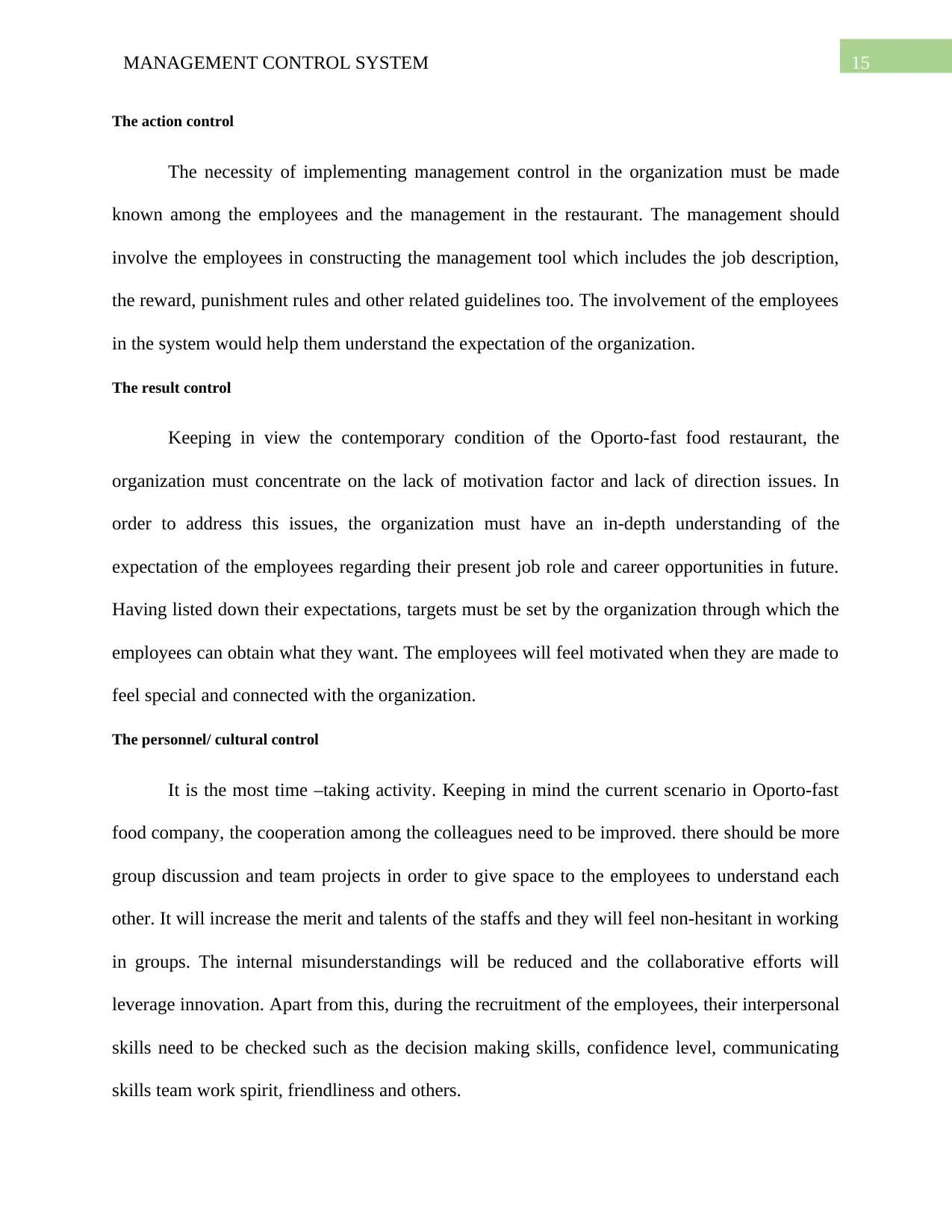
15MANAGEMENT CONTROL SYSTEM
The action control
The necessity of implementing management control in the organization must be made
known among the employees and the management in the restaurant. The management should
involve the employees in constructing the management tool which includes the job description,
the reward, punishment rules and other related guidelines too. The involvement of the employees
in the system would help them understand the expectation of the organization.
The result control
Keeping in view the contemporary condition of the Oporto-fast food restaurant, the
organization must concentrate on the lack of motivation factor and lack of direction issues. In
order to address this issues, the organization must have an in-depth understanding of the
expectation of the employees regarding their present job role and career opportunities in future.
Having listed down their expectations, targets must be set by the organization through which the
employees can obtain what they want. The employees will feel motivated when they are made to
feel special and connected with the organization.
The personnel/ cultural control
It is the most time –taking activity. Keeping in mind the current scenario in Oporto-fast
food company, the cooperation among the colleagues need to be improved. there should be more
group discussion and team projects in order to give space to the employees to understand each
other. It will increase the merit and talents of the staffs and they will feel non-hesitant in working
in groups. The internal misunderstandings will be reduced and the collaborative efforts will
leverage innovation. Apart from this, during the recruitment of the employees, their interpersonal
skills need to be checked such as the decision making skills, confidence level, communicating
skills team work spirit, friendliness and others.
The action control
The necessity of implementing management control in the organization must be made
known among the employees and the management in the restaurant. The management should
involve the employees in constructing the management tool which includes the job description,
the reward, punishment rules and other related guidelines too. The involvement of the employees
in the system would help them understand the expectation of the organization.
The result control
Keeping in view the contemporary condition of the Oporto-fast food restaurant, the
organization must concentrate on the lack of motivation factor and lack of direction issues. In
order to address this issues, the organization must have an in-depth understanding of the
expectation of the employees regarding their present job role and career opportunities in future.
Having listed down their expectations, targets must be set by the organization through which the
employees can obtain what they want. The employees will feel motivated when they are made to
feel special and connected with the organization.
The personnel/ cultural control
It is the most time –taking activity. Keeping in mind the current scenario in Oporto-fast
food company, the cooperation among the colleagues need to be improved. there should be more
group discussion and team projects in order to give space to the employees to understand each
other. It will increase the merit and talents of the staffs and they will feel non-hesitant in working
in groups. The internal misunderstandings will be reduced and the collaborative efforts will
leverage innovation. Apart from this, during the recruitment of the employees, their interpersonal
skills need to be checked such as the decision making skills, confidence level, communicating
skills team work spirit, friendliness and others.
Secure Best Marks with AI Grader
Need help grading? Try our AI Grader for instant feedback on your assignments.
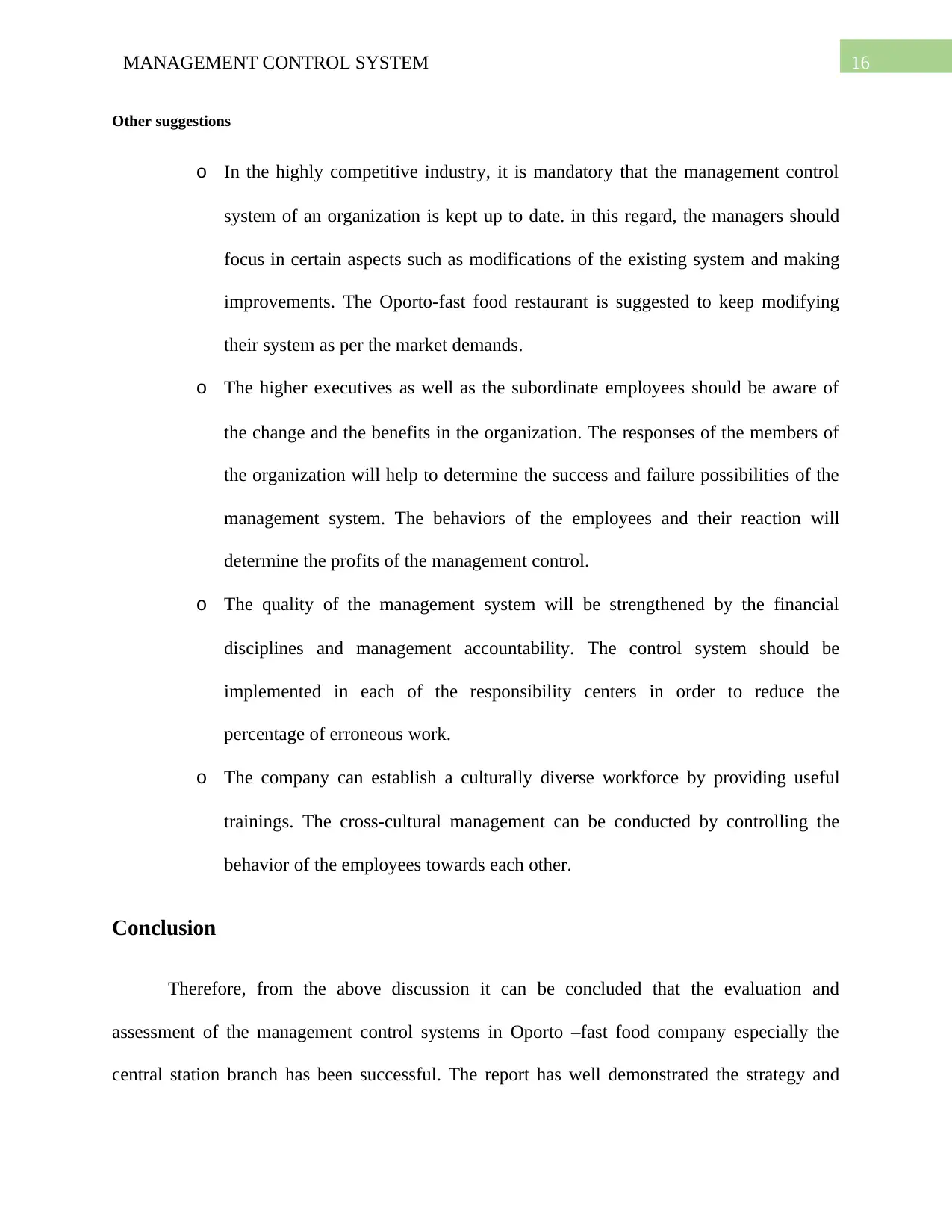
16MANAGEMENT CONTROL SYSTEM
Other suggestions
o In the highly competitive industry, it is mandatory that the management control
system of an organization is kept up to date. in this regard, the managers should
focus in certain aspects such as modifications of the existing system and making
improvements. The Oporto-fast food restaurant is suggested to keep modifying
their system as per the market demands.
o The higher executives as well as the subordinate employees should be aware of
the change and the benefits in the organization. The responses of the members of
the organization will help to determine the success and failure possibilities of the
management system. The behaviors of the employees and their reaction will
determine the profits of the management control.
o The quality of the management system will be strengthened by the financial
disciplines and management accountability. The control system should be
implemented in each of the responsibility centers in order to reduce the
percentage of erroneous work.
o The company can establish a culturally diverse workforce by providing useful
trainings. The cross-cultural management can be conducted by controlling the
behavior of the employees towards each other.
Conclusion
Therefore, from the above discussion it can be concluded that the evaluation and
assessment of the management control systems in Oporto –fast food company especially the
central station branch has been successful. The report has well demonstrated the strategy and
Other suggestions
o In the highly competitive industry, it is mandatory that the management control
system of an organization is kept up to date. in this regard, the managers should
focus in certain aspects such as modifications of the existing system and making
improvements. The Oporto-fast food restaurant is suggested to keep modifying
their system as per the market demands.
o The higher executives as well as the subordinate employees should be aware of
the change and the benefits in the organization. The responses of the members of
the organization will help to determine the success and failure possibilities of the
management system. The behaviors of the employees and their reaction will
determine the profits of the management control.
o The quality of the management system will be strengthened by the financial
disciplines and management accountability. The control system should be
implemented in each of the responsibility centers in order to reduce the
percentage of erroneous work.
o The company can establish a culturally diverse workforce by providing useful
trainings. The cross-cultural management can be conducted by controlling the
behavior of the employees towards each other.
Conclusion
Therefore, from the above discussion it can be concluded that the evaluation and
assessment of the management control systems in Oporto –fast food company especially the
central station branch has been successful. The report has well demonstrated the strategy and
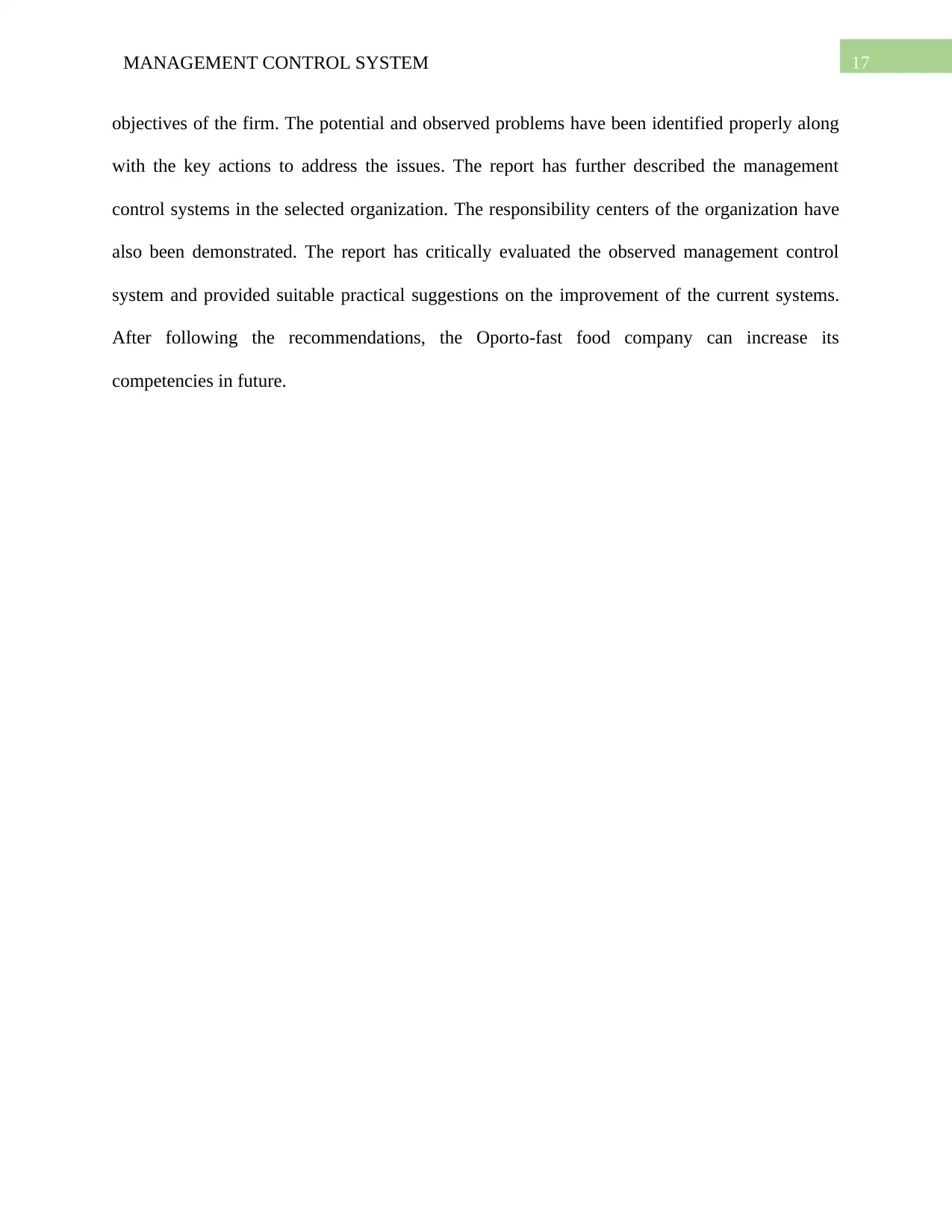
17MANAGEMENT CONTROL SYSTEM
objectives of the firm. The potential and observed problems have been identified properly along
with the key actions to address the issues. The report has further described the management
control systems in the selected organization. The responsibility centers of the organization have
also been demonstrated. The report has critically evaluated the observed management control
system and provided suitable practical suggestions on the improvement of the current systems.
After following the recommendations, the Oporto-fast food company can increase its
competencies in future.
objectives of the firm. The potential and observed problems have been identified properly along
with the key actions to address the issues. The report has further described the management
control systems in the selected organization. The responsibility centers of the organization have
also been demonstrated. The report has critically evaluated the observed management control
system and provided suitable practical suggestions on the improvement of the current systems.
After following the recommendations, the Oporto-fast food company can increase its
competencies in future.
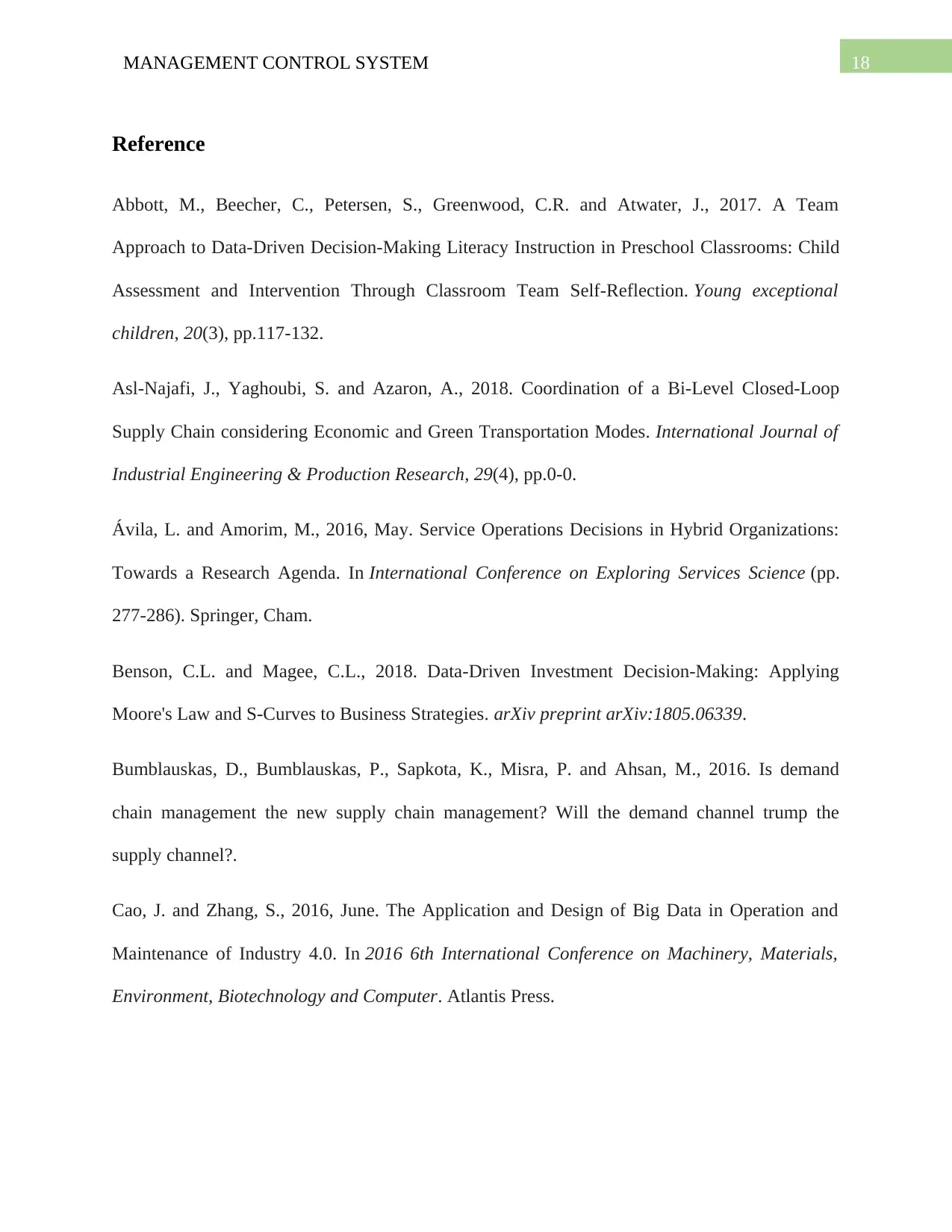
18MANAGEMENT CONTROL SYSTEM
Reference
Abbott, M., Beecher, C., Petersen, S., Greenwood, C.R. and Atwater, J., 2017. A Team
Approach to Data-Driven Decision-Making Literacy Instruction in Preschool Classrooms: Child
Assessment and Intervention Through Classroom Team Self-Reflection. Young exceptional
children, 20(3), pp.117-132.
Asl-Najafi, J., Yaghoubi, S. and Azaron, A., 2018. Coordination of a Bi-Level Closed-Loop
Supply Chain considering Economic and Green Transportation Modes. International Journal of
Industrial Engineering & Production Research, 29(4), pp.0-0.
Ávila, L. and Amorim, M., 2016, May. Service Operations Decisions in Hybrid Organizations:
Towards a Research Agenda. In International Conference on Exploring Services Science (pp.
277-286). Springer, Cham.
Benson, C.L. and Magee, C.L., 2018. Data-Driven Investment Decision-Making: Applying
Moore's Law and S-Curves to Business Strategies. arXiv preprint arXiv:1805.06339.
Bumblauskas, D., Bumblauskas, P., Sapkota, K., Misra, P. and Ahsan, M., 2016. Is demand
chain management the new supply chain management? Will the demand channel trump the
supply channel?.
Cao, J. and Zhang, S., 2016, June. The Application and Design of Big Data in Operation and
Maintenance of Industry 4.0. In 2016 6th International Conference on Machinery, Materials,
Environment, Biotechnology and Computer. Atlantis Press.
Reference
Abbott, M., Beecher, C., Petersen, S., Greenwood, C.R. and Atwater, J., 2017. A Team
Approach to Data-Driven Decision-Making Literacy Instruction in Preschool Classrooms: Child
Assessment and Intervention Through Classroom Team Self-Reflection. Young exceptional
children, 20(3), pp.117-132.
Asl-Najafi, J., Yaghoubi, S. and Azaron, A., 2018. Coordination of a Bi-Level Closed-Loop
Supply Chain considering Economic and Green Transportation Modes. International Journal of
Industrial Engineering & Production Research, 29(4), pp.0-0.
Ávila, L. and Amorim, M., 2016, May. Service Operations Decisions in Hybrid Organizations:
Towards a Research Agenda. In International Conference on Exploring Services Science (pp.
277-286). Springer, Cham.
Benson, C.L. and Magee, C.L., 2018. Data-Driven Investment Decision-Making: Applying
Moore's Law and S-Curves to Business Strategies. arXiv preprint arXiv:1805.06339.
Bumblauskas, D., Bumblauskas, P., Sapkota, K., Misra, P. and Ahsan, M., 2016. Is demand
chain management the new supply chain management? Will the demand channel trump the
supply channel?.
Cao, J. and Zhang, S., 2016, June. The Application and Design of Big Data in Operation and
Maintenance of Industry 4.0. In 2016 6th International Conference on Machinery, Materials,
Environment, Biotechnology and Computer. Atlantis Press.
Paraphrase This Document
Need a fresh take? Get an instant paraphrase of this document with our AI Paraphraser
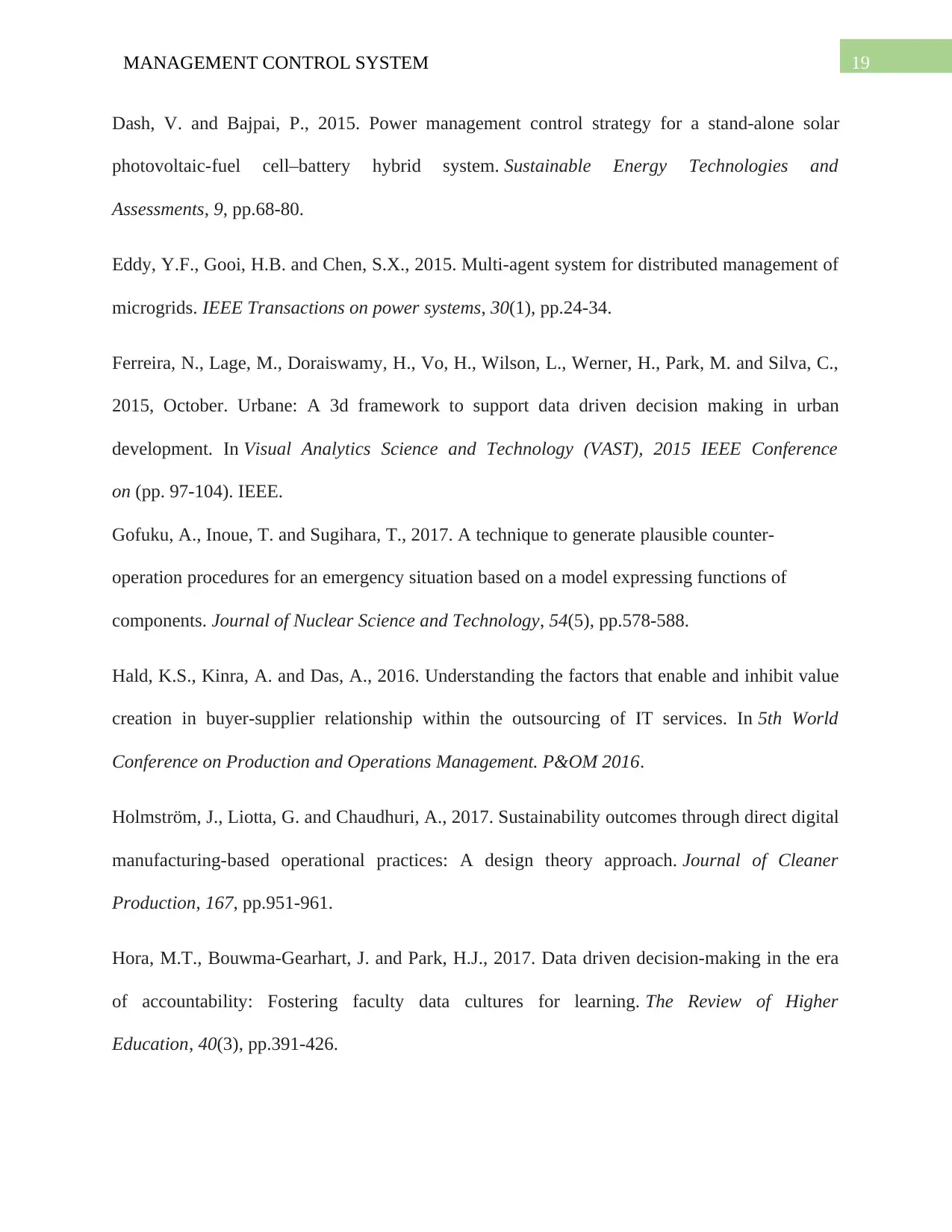
19MANAGEMENT CONTROL SYSTEM
Dash, V. and Bajpai, P., 2015. Power management control strategy for a stand-alone solar
photovoltaic-fuel cell–battery hybrid system. Sustainable Energy Technologies and
Assessments, 9, pp.68-80.
Eddy, Y.F., Gooi, H.B. and Chen, S.X., 2015. Multi-agent system for distributed management of
microgrids. IEEE Transactions on power systems, 30(1), pp.24-34.
Ferreira, N., Lage, M., Doraiswamy, H., Vo, H., Wilson, L., Werner, H., Park, M. and Silva, C.,
2015, October. Urbane: A 3d framework to support data driven decision making in urban
development. In Visual Analytics Science and Technology (VAST), 2015 IEEE Conference
on (pp. 97-104). IEEE.
Gofuku, A., Inoue, T. and Sugihara, T., 2017. A technique to generate plausible counter-
operation procedures for an emergency situation based on a model expressing functions of
components. Journal of Nuclear Science and Technology, 54(5), pp.578-588.
Hald, K.S., Kinra, A. and Das, A., 2016. Understanding the factors that enable and inhibit value
creation in buyer-supplier relationship within the outsourcing of IT services. In 5th World
Conference on Production and Operations Management. P&OM 2016.
Holmström, J., Liotta, G. and Chaudhuri, A., 2017. Sustainability outcomes through direct digital
manufacturing-based operational practices: A design theory approach. Journal of Cleaner
Production, 167, pp.951-961.
Hora, M.T., Bouwma-Gearhart, J. and Park, H.J., 2017. Data driven decision-making in the era
of accountability: Fostering faculty data cultures for learning. The Review of Higher
Education, 40(3), pp.391-426.
Dash, V. and Bajpai, P., 2015. Power management control strategy for a stand-alone solar
photovoltaic-fuel cell–battery hybrid system. Sustainable Energy Technologies and
Assessments, 9, pp.68-80.
Eddy, Y.F., Gooi, H.B. and Chen, S.X., 2015. Multi-agent system for distributed management of
microgrids. IEEE Transactions on power systems, 30(1), pp.24-34.
Ferreira, N., Lage, M., Doraiswamy, H., Vo, H., Wilson, L., Werner, H., Park, M. and Silva, C.,
2015, October. Urbane: A 3d framework to support data driven decision making in urban
development. In Visual Analytics Science and Technology (VAST), 2015 IEEE Conference
on (pp. 97-104). IEEE.
Gofuku, A., Inoue, T. and Sugihara, T., 2017. A technique to generate plausible counter-
operation procedures for an emergency situation based on a model expressing functions of
components. Journal of Nuclear Science and Technology, 54(5), pp.578-588.
Hald, K.S., Kinra, A. and Das, A., 2016. Understanding the factors that enable and inhibit value
creation in buyer-supplier relationship within the outsourcing of IT services. In 5th World
Conference on Production and Operations Management. P&OM 2016.
Holmström, J., Liotta, G. and Chaudhuri, A., 2017. Sustainability outcomes through direct digital
manufacturing-based operational practices: A design theory approach. Journal of Cleaner
Production, 167, pp.951-961.
Hora, M.T., Bouwma-Gearhart, J. and Park, H.J., 2017. Data driven decision-making in the era
of accountability: Fostering faculty data cultures for learning. The Review of Higher
Education, 40(3), pp.391-426.
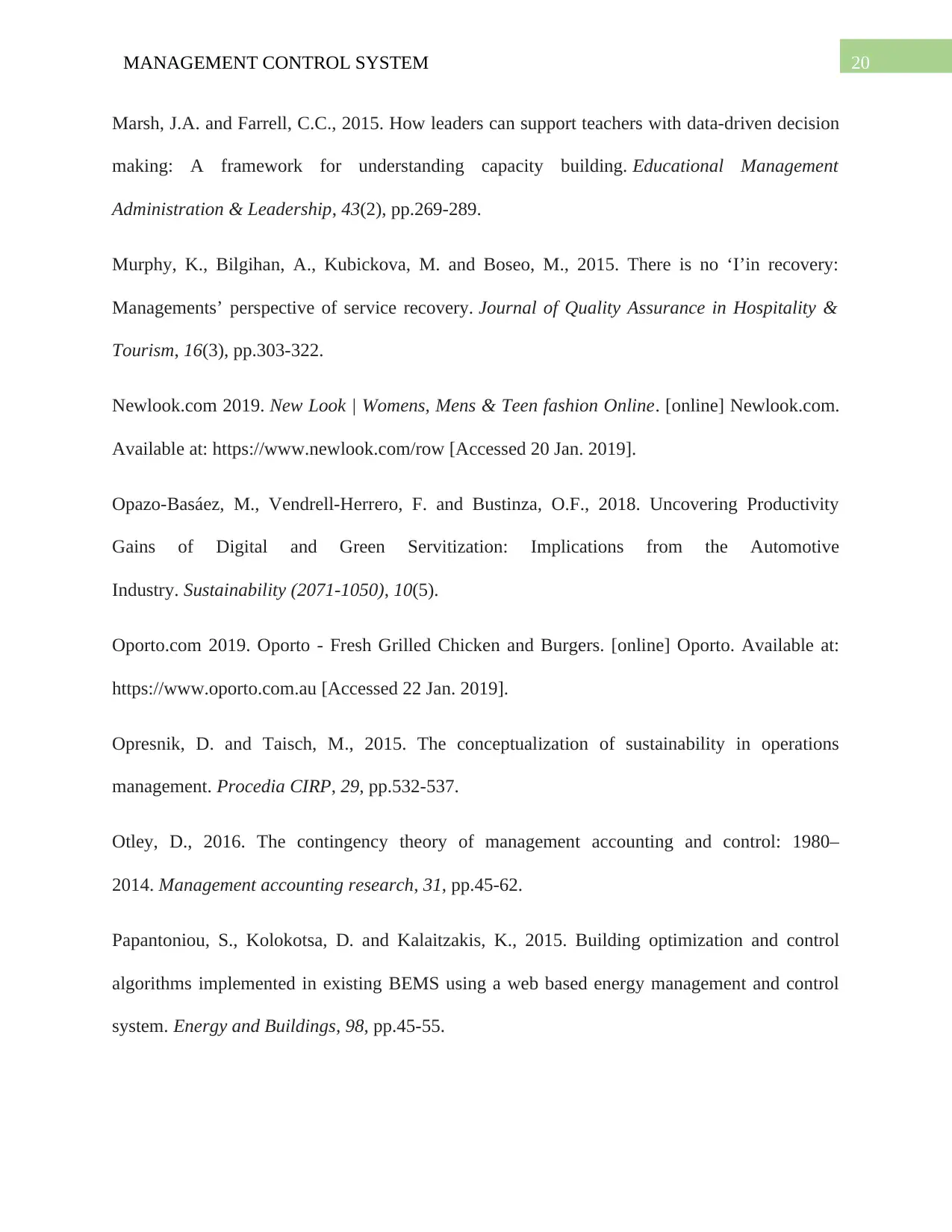
20MANAGEMENT CONTROL SYSTEM
Marsh, J.A. and Farrell, C.C., 2015. How leaders can support teachers with data-driven decision
making: A framework for understanding capacity building. Educational Management
Administration & Leadership, 43(2), pp.269-289.
Murphy, K., Bilgihan, A., Kubickova, M. and Boseo, M., 2015. There is no ‘I’in recovery:
Managements’ perspective of service recovery. Journal of Quality Assurance in Hospitality &
Tourism, 16(3), pp.303-322.
Newlook.com 2019. New Look | Womens, Mens & Teen fashion Online. [online] Newlook.com.
Available at: https://www.newlook.com/row [Accessed 20 Jan. 2019].
Opazo-Basáez, M., Vendrell-Herrero, F. and Bustinza, O.F., 2018. Uncovering Productivity
Gains of Digital and Green Servitization: Implications from the Automotive
Industry. Sustainability (2071-1050), 10(5).
Oporto.com 2019. Oporto - Fresh Grilled Chicken and Burgers. [online] Oporto. Available at:
https://www.oporto.com.au [Accessed 22 Jan. 2019].
Opresnik, D. and Taisch, M., 2015. The conceptualization of sustainability in operations
management. Procedia CIRP, 29, pp.532-537.
Otley, D., 2016. The contingency theory of management accounting and control: 1980–
2014. Management accounting research, 31, pp.45-62.
Papantoniou, S., Kolokotsa, D. and Kalaitzakis, K., 2015. Building optimization and control
algorithms implemented in existing BEMS using a web based energy management and control
system. Energy and Buildings, 98, pp.45-55.
Marsh, J.A. and Farrell, C.C., 2015. How leaders can support teachers with data-driven decision
making: A framework for understanding capacity building. Educational Management
Administration & Leadership, 43(2), pp.269-289.
Murphy, K., Bilgihan, A., Kubickova, M. and Boseo, M., 2015. There is no ‘I’in recovery:
Managements’ perspective of service recovery. Journal of Quality Assurance in Hospitality &
Tourism, 16(3), pp.303-322.
Newlook.com 2019. New Look | Womens, Mens & Teen fashion Online. [online] Newlook.com.
Available at: https://www.newlook.com/row [Accessed 20 Jan. 2019].
Opazo-Basáez, M., Vendrell-Herrero, F. and Bustinza, O.F., 2018. Uncovering Productivity
Gains of Digital and Green Servitization: Implications from the Automotive
Industry. Sustainability (2071-1050), 10(5).
Oporto.com 2019. Oporto - Fresh Grilled Chicken and Burgers. [online] Oporto. Available at:
https://www.oporto.com.au [Accessed 22 Jan. 2019].
Opresnik, D. and Taisch, M., 2015. The conceptualization of sustainability in operations
management. Procedia CIRP, 29, pp.532-537.
Otley, D., 2016. The contingency theory of management accounting and control: 1980–
2014. Management accounting research, 31, pp.45-62.
Papantoniou, S., Kolokotsa, D. and Kalaitzakis, K., 2015. Building optimization and control
algorithms implemented in existing BEMS using a web based energy management and control
system. Energy and Buildings, 98, pp.45-55.
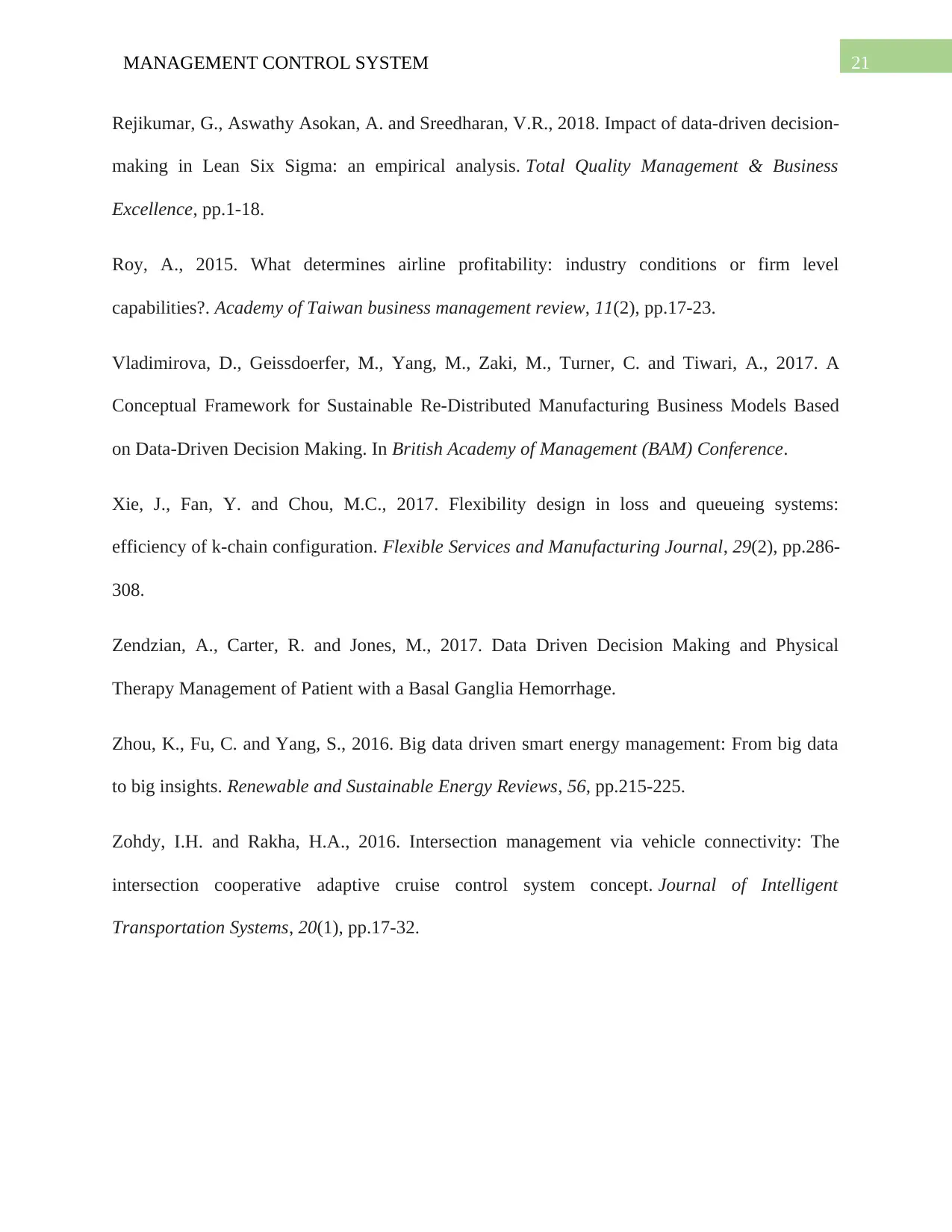
21MANAGEMENT CONTROL SYSTEM
Rejikumar, G., Aswathy Asokan, A. and Sreedharan, V.R., 2018. Impact of data-driven decision-
making in Lean Six Sigma: an empirical analysis. Total Quality Management & Business
Excellence, pp.1-18.
Roy, A., 2015. What determines airline profitability: industry conditions or firm level
capabilities?. Academy of Taiwan business management review, 11(2), pp.17-23.
Vladimirova, D., Geissdoerfer, M., Yang, M., Zaki, M., Turner, C. and Tiwari, A., 2017. A
Conceptual Framework for Sustainable Re-Distributed Manufacturing Business Models Based
on Data-Driven Decision Making. In British Academy of Management (BAM) Conference.
Xie, J., Fan, Y. and Chou, M.C., 2017. Flexibility design in loss and queueing systems:
efficiency of k-chain configuration. Flexible Services and Manufacturing Journal, 29(2), pp.286-
308.
Zendzian, A., Carter, R. and Jones, M., 2017. Data Driven Decision Making and Physical
Therapy Management of Patient with a Basal Ganglia Hemorrhage.
Zhou, K., Fu, C. and Yang, S., 2016. Big data driven smart energy management: From big data
to big insights. Renewable and Sustainable Energy Reviews, 56, pp.215-225.
Zohdy, I.H. and Rakha, H.A., 2016. Intersection management via vehicle connectivity: The
intersection cooperative adaptive cruise control system concept. Journal of Intelligent
Transportation Systems, 20(1), pp.17-32.
Rejikumar, G., Aswathy Asokan, A. and Sreedharan, V.R., 2018. Impact of data-driven decision-
making in Lean Six Sigma: an empirical analysis. Total Quality Management & Business
Excellence, pp.1-18.
Roy, A., 2015. What determines airline profitability: industry conditions or firm level
capabilities?. Academy of Taiwan business management review, 11(2), pp.17-23.
Vladimirova, D., Geissdoerfer, M., Yang, M., Zaki, M., Turner, C. and Tiwari, A., 2017. A
Conceptual Framework for Sustainable Re-Distributed Manufacturing Business Models Based
on Data-Driven Decision Making. In British Academy of Management (BAM) Conference.
Xie, J., Fan, Y. and Chou, M.C., 2017. Flexibility design in loss and queueing systems:
efficiency of k-chain configuration. Flexible Services and Manufacturing Journal, 29(2), pp.286-
308.
Zendzian, A., Carter, R. and Jones, M., 2017. Data Driven Decision Making and Physical
Therapy Management of Patient with a Basal Ganglia Hemorrhage.
Zhou, K., Fu, C. and Yang, S., 2016. Big data driven smart energy management: From big data
to big insights. Renewable and Sustainable Energy Reviews, 56, pp.215-225.
Zohdy, I.H. and Rakha, H.A., 2016. Intersection management via vehicle connectivity: The
intersection cooperative adaptive cruise control system concept. Journal of Intelligent
Transportation Systems, 20(1), pp.17-32.
Secure Best Marks with AI Grader
Need help grading? Try our AI Grader for instant feedback on your assignments.
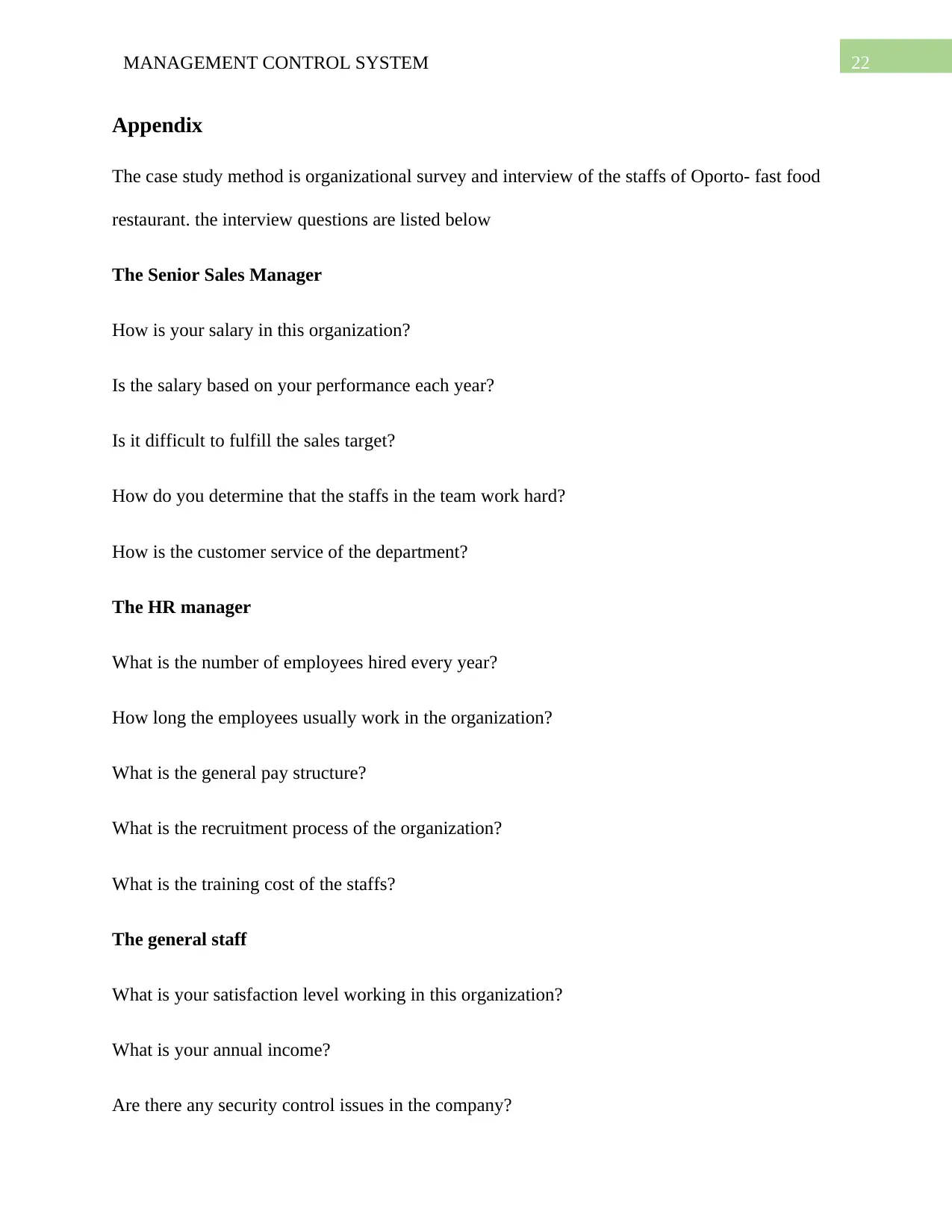
22MANAGEMENT CONTROL SYSTEM
Appendix
The case study method is organizational survey and interview of the staffs of Oporto- fast food
restaurant. the interview questions are listed below
The Senior Sales Manager
How is your salary in this organization?
Is the salary based on your performance each year?
Is it difficult to fulfill the sales target?
How do you determine that the staffs in the team work hard?
How is the customer service of the department?
The HR manager
What is the number of employees hired every year?
How long the employees usually work in the organization?
What is the general pay structure?
What is the recruitment process of the organization?
What is the training cost of the staffs?
The general staff
What is your satisfaction level working in this organization?
What is your annual income?
Are there any security control issues in the company?
Appendix
The case study method is organizational survey and interview of the staffs of Oporto- fast food
restaurant. the interview questions are listed below
The Senior Sales Manager
How is your salary in this organization?
Is the salary based on your performance each year?
Is it difficult to fulfill the sales target?
How do you determine that the staffs in the team work hard?
How is the customer service of the department?
The HR manager
What is the number of employees hired every year?
How long the employees usually work in the organization?
What is the general pay structure?
What is the recruitment process of the organization?
What is the training cost of the staffs?
The general staff
What is your satisfaction level working in this organization?
What is your annual income?
Are there any security control issues in the company?
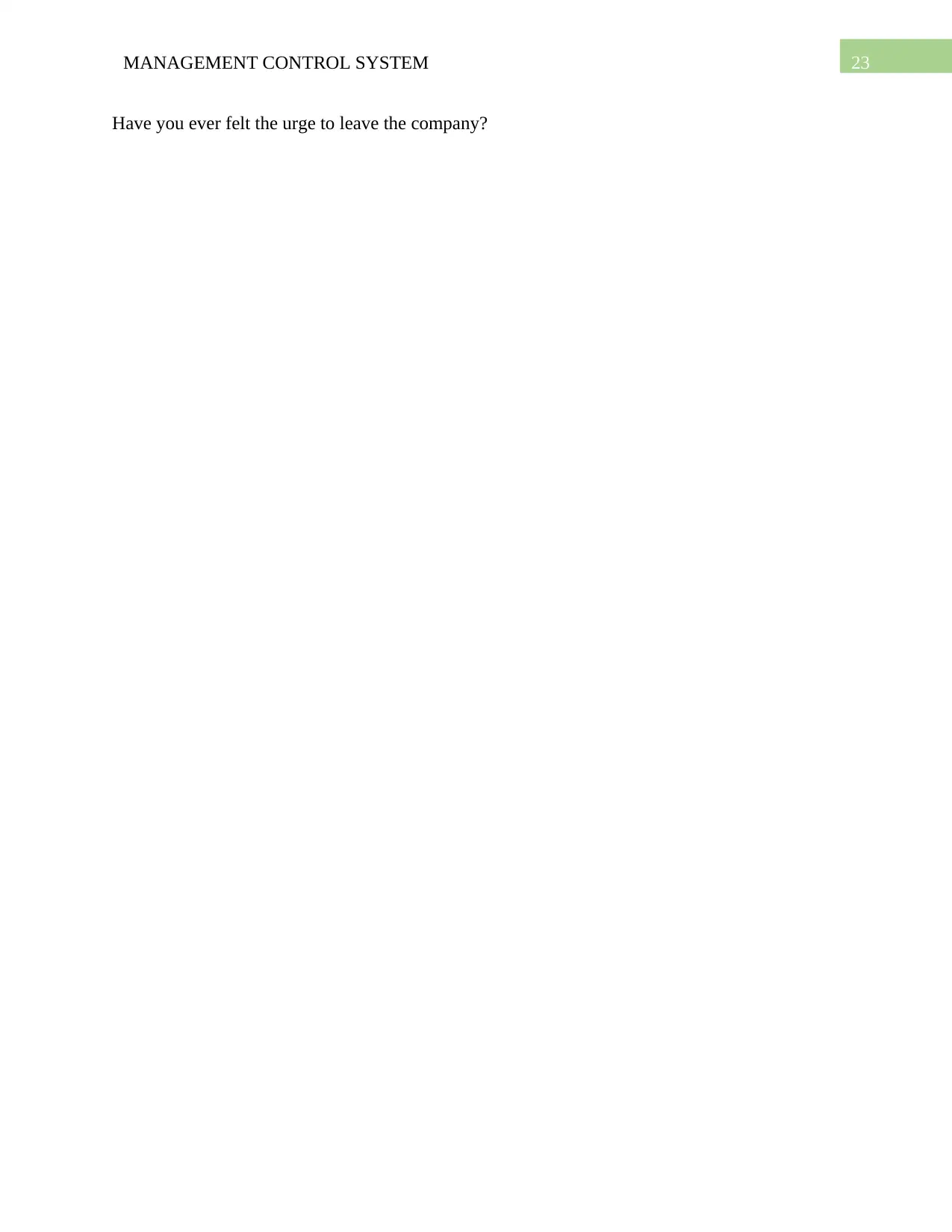
23MANAGEMENT CONTROL SYSTEM
Have you ever felt the urge to leave the company?
Have you ever felt the urge to leave the company?
1 out of 24
Related Documents
Your All-in-One AI-Powered Toolkit for Academic Success.
+13062052269
info@desklib.com
Available 24*7 on WhatsApp / Email
![[object Object]](/_next/static/media/star-bottom.7253800d.svg)
Unlock your academic potential
© 2024 | Zucol Services PVT LTD | All rights reserved.




